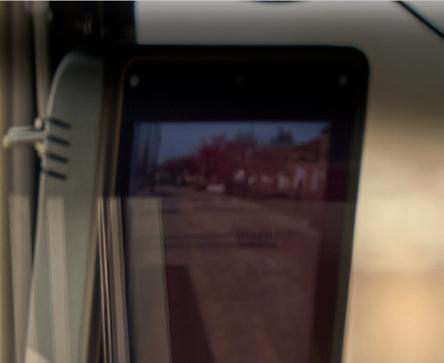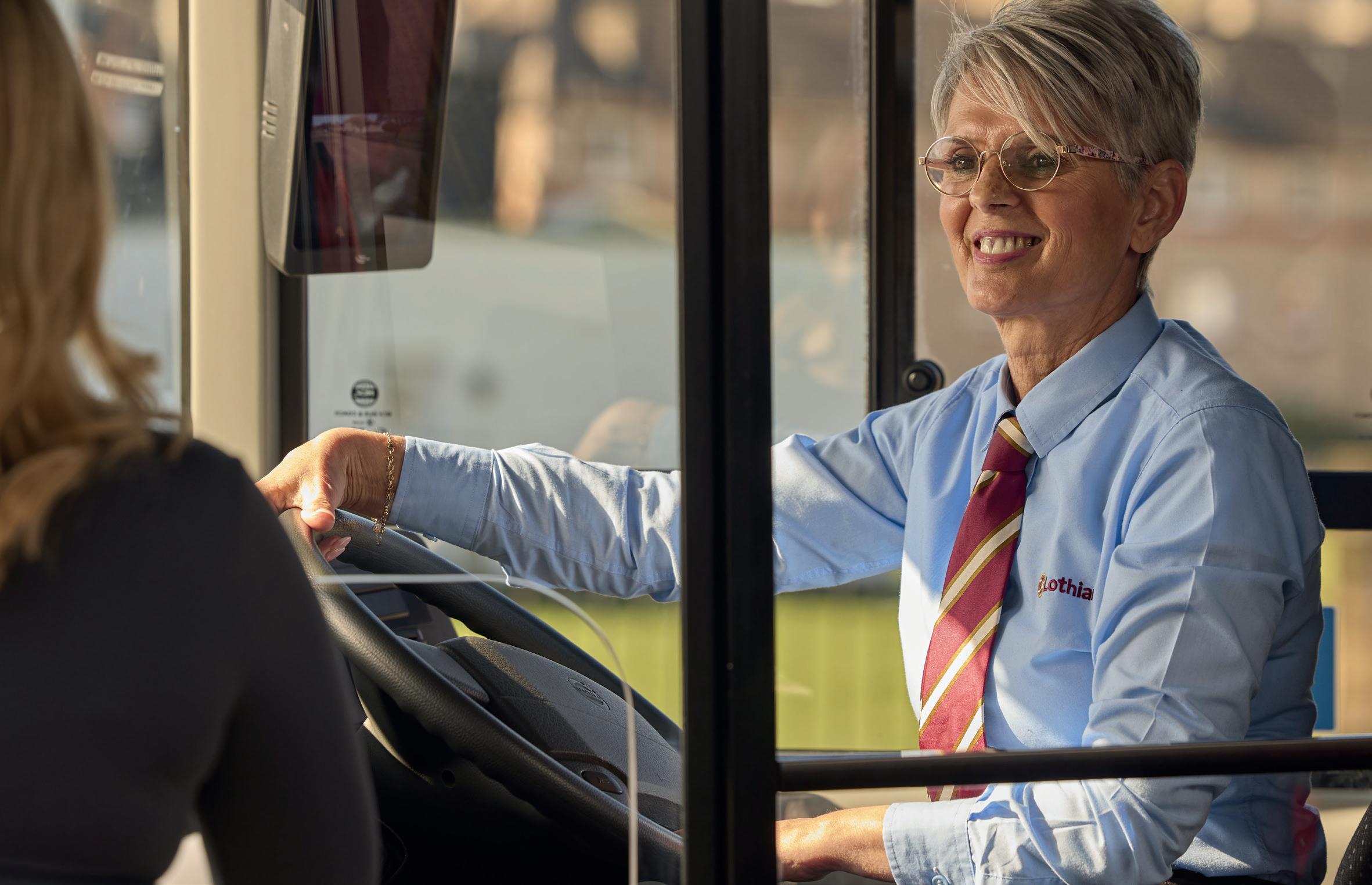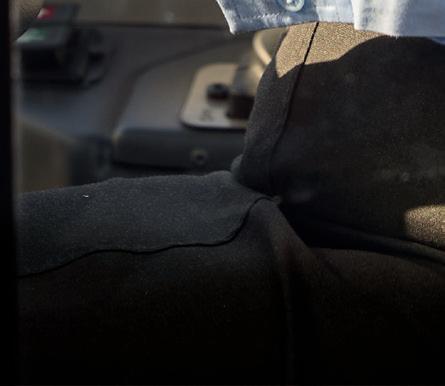




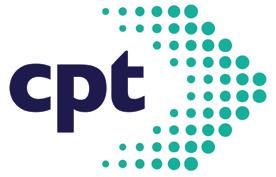
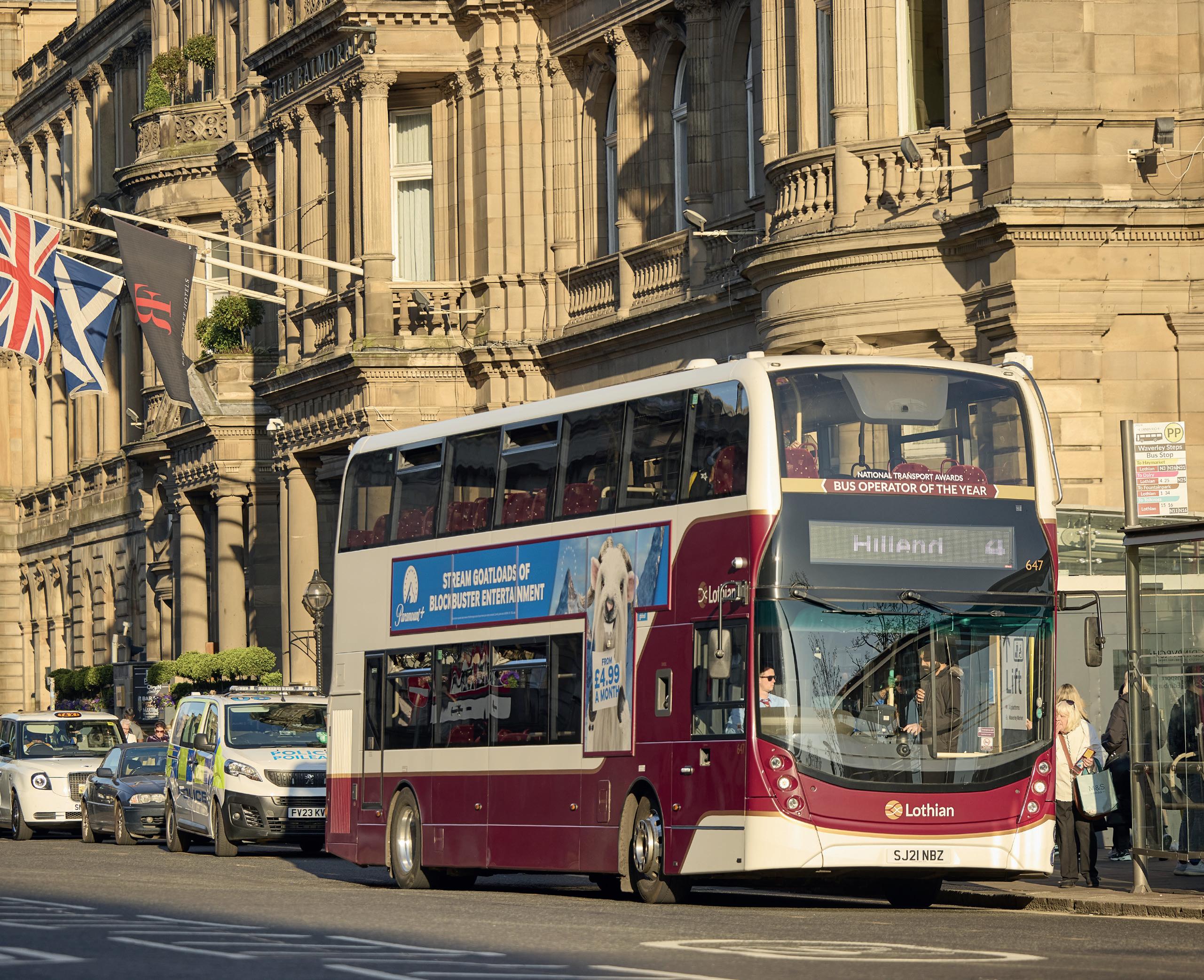
97% grid-to-wheel efficiency
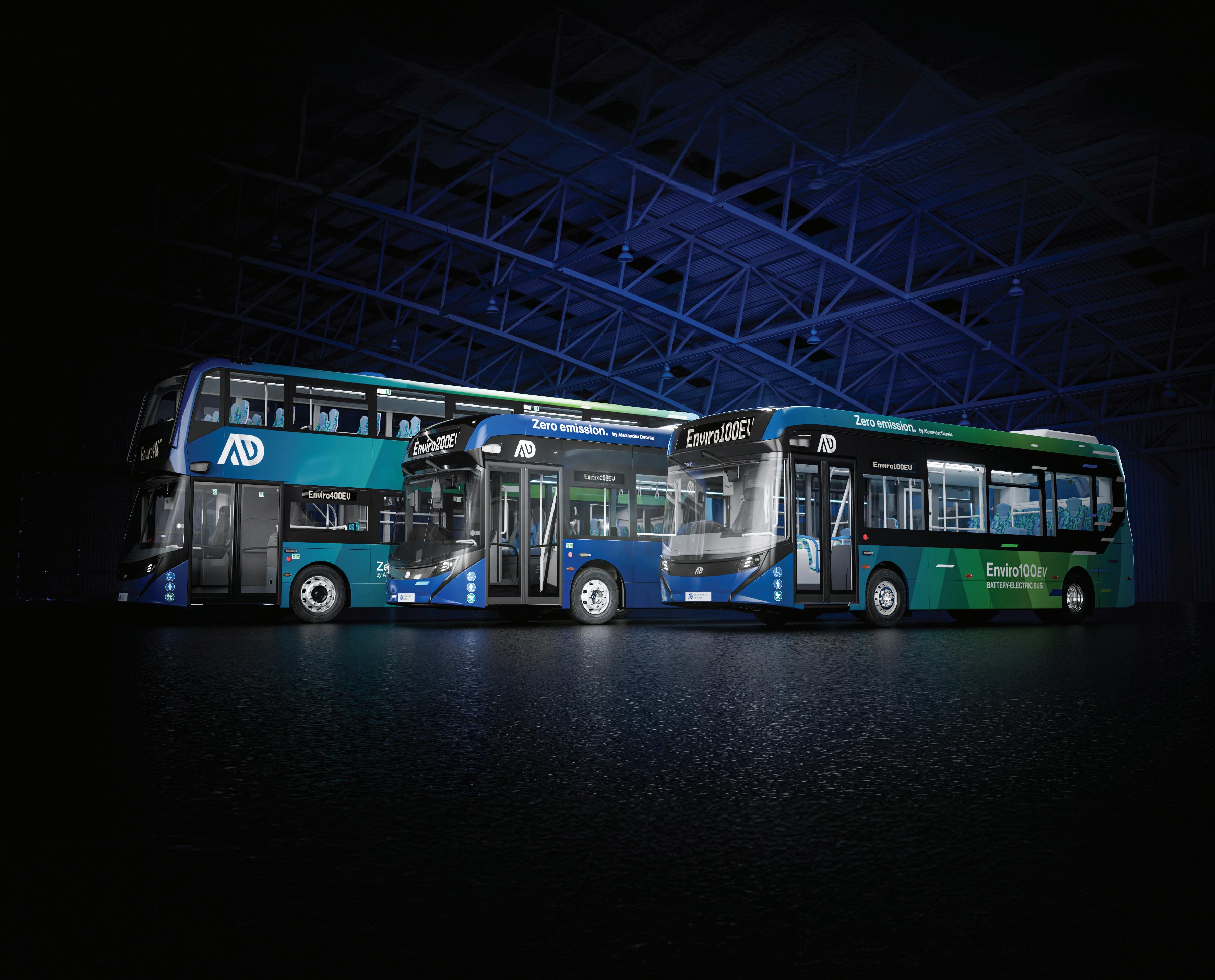
Charge your transition to zero emission at maximum efficiency with the next generation of Alexander Dennis electric buses.
From the Enviro100EV “big small bus” to the Enviro200EV all-rounder and Enviro400EV crowd-shifter, Alexander Dennis next-generation electric buses keep energy losses to a minimum with best-in-class 97% grid-to-wheel efficiency demonstrated in Zemo Partnership zero-emission bus testing.
Manage your zero-emission buses with AD Connect telematics delivering market-leading data availability and engagement for fleet optimisation!
Welcome to Scotland’s Buses 2025. This special publication from Passenger Transport, highlights the achievements of Scotland’s bus and coach industry and its partners, and considers the many challenges they face. Published in association with CPT for an eighth time, this year’s edition incorporates the official Conference Workbook for the 47th annual CPT Annual Conference, which takes place at the Kimpton Charlotte Square in Edinburgh on October 27-28.
Minister for Agriculture and Connectivity, sees a bright future for buses
We speak to the Chair of CPT Scotland and Chief Executive of Lothian
Strategy Manager Rachael Murphy on creating a regional strategy for buses
Margaret Roy, Chair of ATCO Scotland, calls for a collaborative mindset
REVIEW OF PAST YEAR
A look back at key events for buses in Scotland over the past 12 months

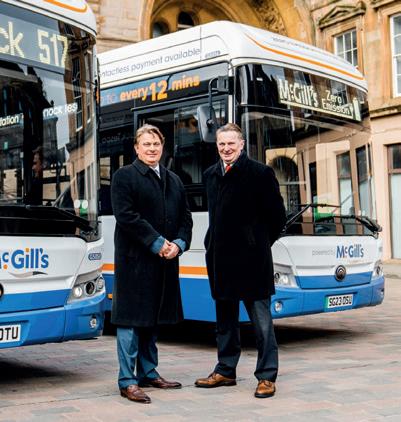
Kevin Hamilton on his role as Scottish Road Works Commissioner
ATCO SCOTLAND UNITE 14 4 6 10 16 18 17 19 21 23 25 27
Paul Davies, President and MD of Alexander Dennis, offers solutions
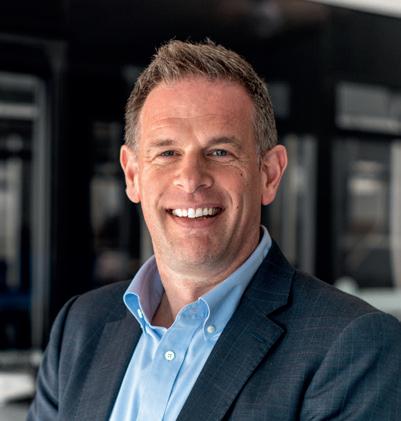
HITRANS
HITRANS Director Ranald Robertson calls for a rethink on bus funding
Dougie Maguire, Unite regional coordinator, champions bus staff
Duncan Cameron, MD of First Bus Scotland calls for collaboration
Control360's joined-up view is ushering in a new era for UK bus operations
The official Workbook for the 47th annual CPT Conference
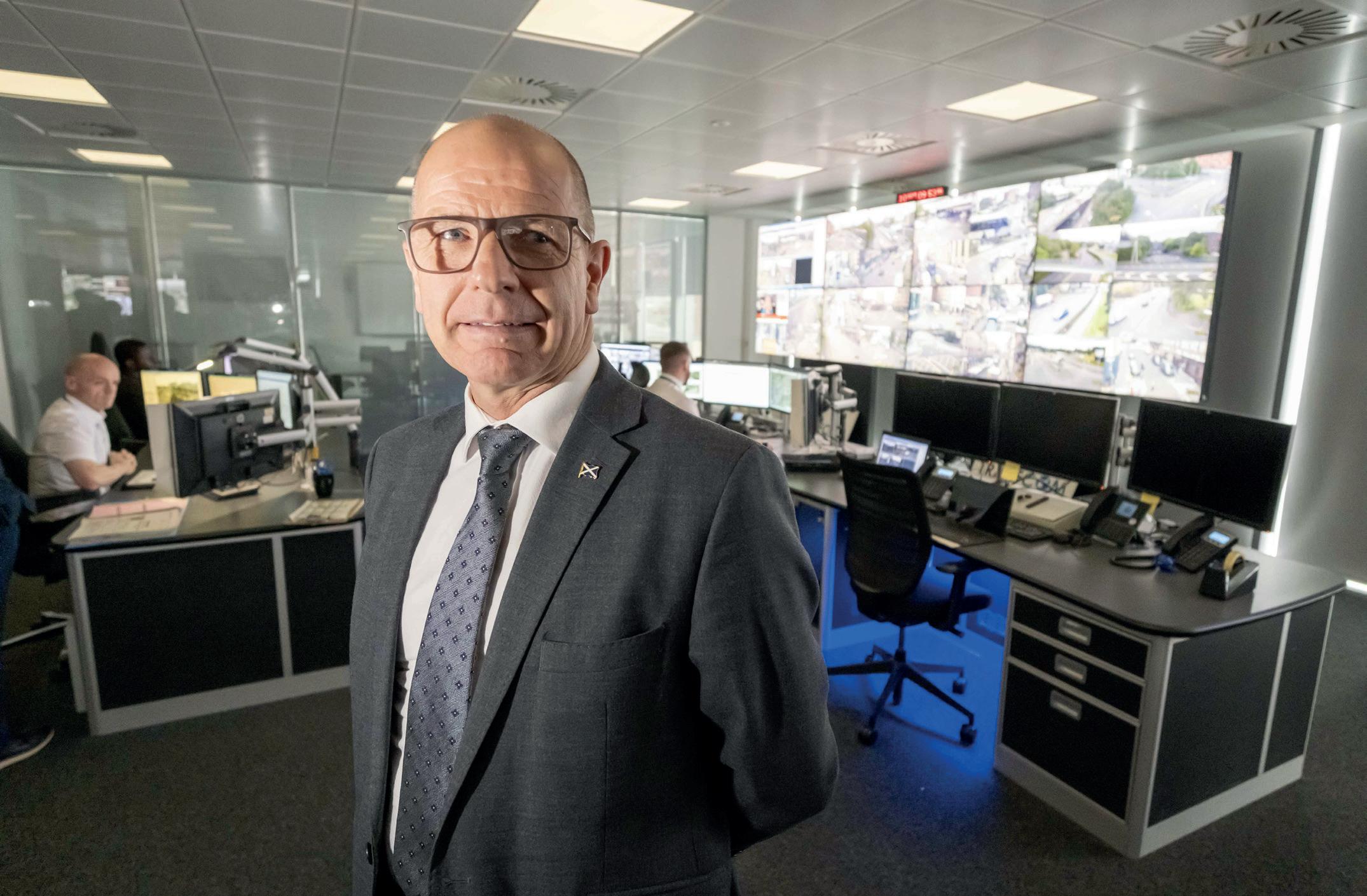
I’m grateful to again be contributing ahead of the CPT Scotland Conference and reflecting on another eventful year for the bus and coach sector.
When we consider the First Minister’s four priorities for Government - growing the economy, eradicating child poverty, tackling the climate emergency and ensuring high-quality and sustainable public services - we can draw direct lines between all of those objectives and the role that bus and coach can and does play each and every day.
The climate emergency is our single greatest challenge, and
transport remains the largest source of carbon emissions, but as I’ve said before, we’ve got many of the tools we need to address these complex challenges. Whether it’s reducing emissions, tackling transport poverty, easing congestion or improving air quality - bus remains best for our towns and cities.
People and communities know this and choose bus too, as that’s why they are still the most popular mode of public transport here in Scotland. As such, I’m proud of what the Scottish Government has done and will continue to do to support this vital sector.
Through the 2025-26 budget, we are providing £415m for concessionary bus travel,
providing access to free bus travel for over 2.3 million people in Scotland. It is the most generous scheme of its kind in the UK. We will also progress a national pilot to extend free bus travel to people seeking asylum - all working to ensure that we continue to help those who need it most.
We are providing funding of £50m in support for bus services to ensure our bus operators are able to continue providing critical access to affordable transport via the Network Support Grant.
I also recently announced £20m through our transformative Bus Infrastructure Fund. This investment supports the development and construction of a wide range of infrastructure
projects across Scotland - from bus lanes and bus priority signals to accessible features and transport hubs. These improvements are designed to shorten journey times, increase reliability, and improve integration with other modes of transport, ultimately encouraging more people to choose the bus.
We invest all of this because bus offers a more sustainable way to keep our country moving, in a way which is accessible to many. When we think about congestion and private car use, each full bus can take up to 75 cars off the road, making every bus journey better for our climate. When buses and coaches are decarbonised, of course those
benefits are even greater.
This is why we took the important step of announcing further investment of up to £40m this year through the second Scottish Zero Emission Bus Challenge Fund, which could bring as many as 300 zero-emission buses to Scotland’s bus operators.
Since 2020, we have previously invested over £154m in zeroemission buses and infrastructure. By supporting collaborative projects and shared infrastructure, we’re ensuring that the benefits of decarbonisation reach every corner of Scotland - from city centres to rural communities.
With every £1 of public funding leveraging over £3 of private investment, ScotZEB2 has exemplified how government and industry can work together to deliver sustainable, inclusive transport solutions. ScotZEB2 is not only reducing emissionsit’s supporting jobs, connecting communities, improving air quality, and continuing to build a cleaner, greener Scotland.
We haven’t stopped therebecause every organisation should be able to take effective climate action. That’s why we’ve made £4m available to community transport operators to apply for Scottish Government funding to invest in zero-emission vehicles and charging infrastructure - including for wheelchair-accessible vehicles.
Since the launch of the Plugged-in Communities Fund in 2021, over £4.2m in grants has been provided to 49 community transport organisations. This has allowed them to procure 64 new zero-emission vehicles to replace their current diesel vehicles. By switching their vehicles to electric, the recipients of the fund have saved around 8,000 tonnes of CO₂ - which is about the same amount of CO₂ you would generate by driving a Volvo B9TL around the world over 190 times.
To further encourage a switch to zero emission buses, we will be bringing in regulations to prohibit the registration of new diesel buses from a date no earlier than 2030. We will continue to engage with stakeholders while developing these regulations and I look forward to hearing your views. When I attended the conference last year, I celebrated the fact that
“Since the launch of the Plugged-in Communities Fund in 2021, over £4.2 million in grants has been provided to 49 community transport organisations”
150 million free bus journeys had been made by people under 22 since the transformational policy began in 2022. This year, we’ve reached over 250 million free bus journeys, which is an incredible achievement.
It’s not just money saved, or emissions reduced - it’s our young people getting to work, getting to education; developing new opportunities and perspectives through free connectivity. It is a benefit which is profoundly important in so many ways.
This couldn’t happen without CPT Scotland and CPT Scotland members continuing to promote the scheme, even where anti-social behaviour has been experienced. I know that where this does occur, it can have an unpleasant and sometimes devastating effect on drivers and other passengers.
When considering that over 250 million trips have been made by under-22s across Scotland, we also know that the vast majority of passengers travelling by bus travel safely and responsibly, including people of all ages using their free bus entitlement to travel. There remains, however, a minority of people, of all ages, who act in a way which can result in harm to
bus employees and passengers. That is simply not acceptable. In our Programme for Government this year, we confirmed that we are considering suspending the use of concessionary travel cards on a temporary and potentially permanent basis as a result of anti-social behaviour when using the card.
Detailed work on the timescale and best mechanism for achieving this is still underway, including robust impact assessments. The development of a behaviour code and whether future primary or secondary legislation is required will be part of this process to ensure fair decision-making. I have the greatest sympathy for bus drivers who are affected by antisocial behaviour. Everyone should be able to go to their work without fear of abuse. We’re continuing discussions with unions, operators, Police Scotland and CPT Scotland to ensure we get this right.
Collaboration is key to overcoming these complex challenges, whether it’s about anti-social behaviour, reducing congestion or improving services more widely. That collaboration also extends to our local authorities and regional
“There is optimism, there is terrific humour and there is a real shared sense of purpose that comes with keeping communities connected”
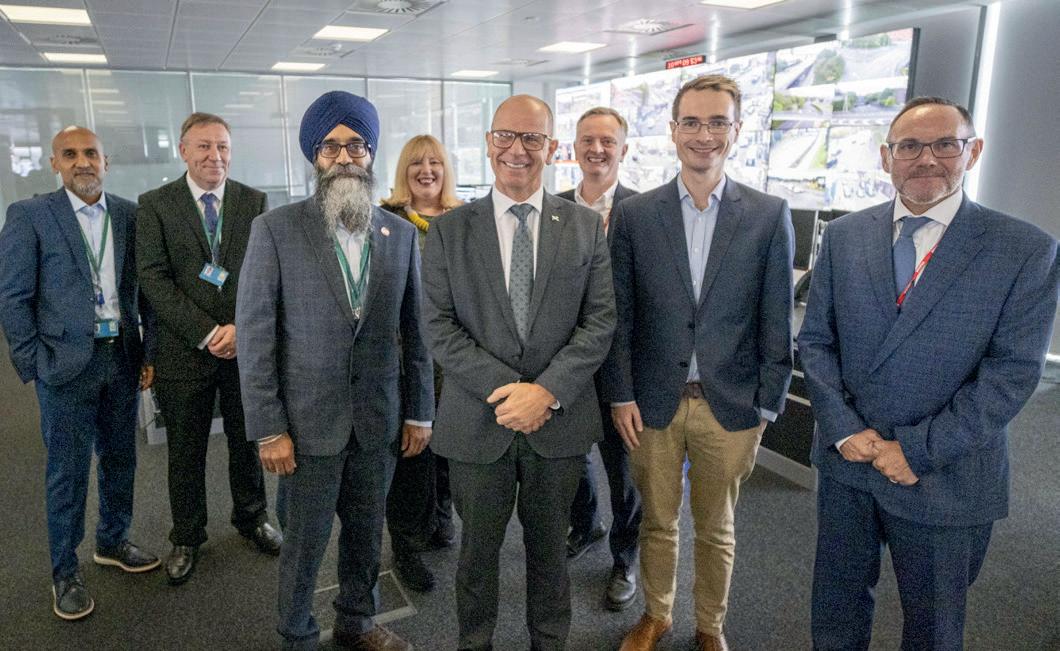
transport partnerships who are also working every day to ensure a more integrated and accessible public transport system.
The Transport (Scotland) Act 2019 has now delivered the powers for local transport authorities and regional transport partnerships to take forward partnership working, franchising, and local authority-run services, alongside the ability to subsidise services.
Our approach enables local transport authorities to determine what is best to address any transport challenges in their local areas, and we want all local transport authorities to consider the 2019 Act powers to improve bus services within their areas.
Last month, Strathclyde Partnership for Transport announced plans for bus franchising across the region. This followed a local consultation which showed 83% support for taking forward these plans. I am pleased to see the Transport Act powers being used and encourage all local authorities to explore the options within the 2019 Act.
A remaining aspect to address is around affordability. To respond to this, the Scottish Government will progress a pilot scheme for a £2 bus fare cap in one of Scotland’s transport regions, backed by £3 million in this financial year.
Working in partnership with CPT members who are driving down emissions, promoting concessionary travel, innovating digitally and supporting jobs and education, my belief is that the future of bus in Scotland is bright and will be brighter still.
I’ve had the pleasure of getting out and about to meet staff and drivers over the course of the year. I’ve met young people starting their careers in the industry and I’ve met people with many more years of experience. There is optimism, there is terrific humour and there is a real shared sense of purpose that comes with keeping communities connected.
My thanks again to everyone involved in Scotland’s bus and coach sector. I’m certain that with the support of CPT Scotland and the support of all its members, we’ll keep working in partnership to encourage more people to get on board and to choose more sustainable public transport.
It’s been an eventful year for Sarah Boyd. Now three years into her role as Managing Director of Lothian - the UK’s largest remaining municipal bus operator - she is also serving as Chair of CPT Scotland, representing members’ views to government and stakeholders.
Last month it was also announced she would become Chief Executive of Lothian, with her remit expanded to cover the integration of the bus operator with Edinburgh Trams.
And the recognition keeps coming: on October 9, Sarah was named ‘Director of the Year’ at the Institute of Directors (IoD) Scotland Director of the Year Awards in the Medium/Large Business category.
Amid all of this, she found time to run the 2025 Scottish Half Marathon in August.
A difficult balancing act
It’s also been another eventful year for buses in Scotland. Bus use has continued to increase across Scotland, but rising costs present a major challenge.
“I think the mood is twofold,” says Sarah. “There is optimism around customer numbers. The recovery for most continues to be strong.
“However, I’ve been in the industry 23 years and there is such a challenge with costs now, no matter what the category.”
Labour costs make up more than 50% of bus company costs and Sarah says that, coming out of the pandemic, wage increases have been “almost unprecedented”.
Additionally, the impact of the
UK Government’s decision to increase the rate of employers’ National Insurance Contributions from 13.8% to 15% from 6 April 2025 has been “huge”
“What we’ve got now at Lothian is a really strong employment offering which attracts really good talent, and retains that talent,” says Sarah. “That is so important, and we wouldn’t have it any other way.
“But we have to be able to sustain those costs and it’s becoming increasingly difficult to balance all that.”
Support from government Sarah is once again chairing CPT Scotland, having previously held the position in 2014/15. As a figurehead for the organisation, she has been making the case for continued support to the Scottish Government.
Asked what she is looking for from the government, she says: “If there was more that could be done, it would be around certainty.”
The industry is seeking clarity on reimbursement rates for concessionary travel schemes. Meanwhile, The Network Service Grant (NSG), which subsidises commercial and community bus routes, has not changed since 2012.
The bus sector sometimes casts an envious eye at the rail sector, which receives much greater levels of financial support despite carrying far fewer passengers.
Sarah notes that 78% of all Scotland’s public transport journeys are made by bus, yet “there’s pounds per person of rail subsidy versus pennies per person bus subsidy”.
“For me, what would be really interesting would be to gross all that up and to discuss a bus vision,” she says. “What could you actually achieve if you were to take some kind of like-for-like passenger subsidy? What would that look like and what would that achieve in real terms of 78% of all the journeys?
“There’s a huge opportunity to do something that’s never been
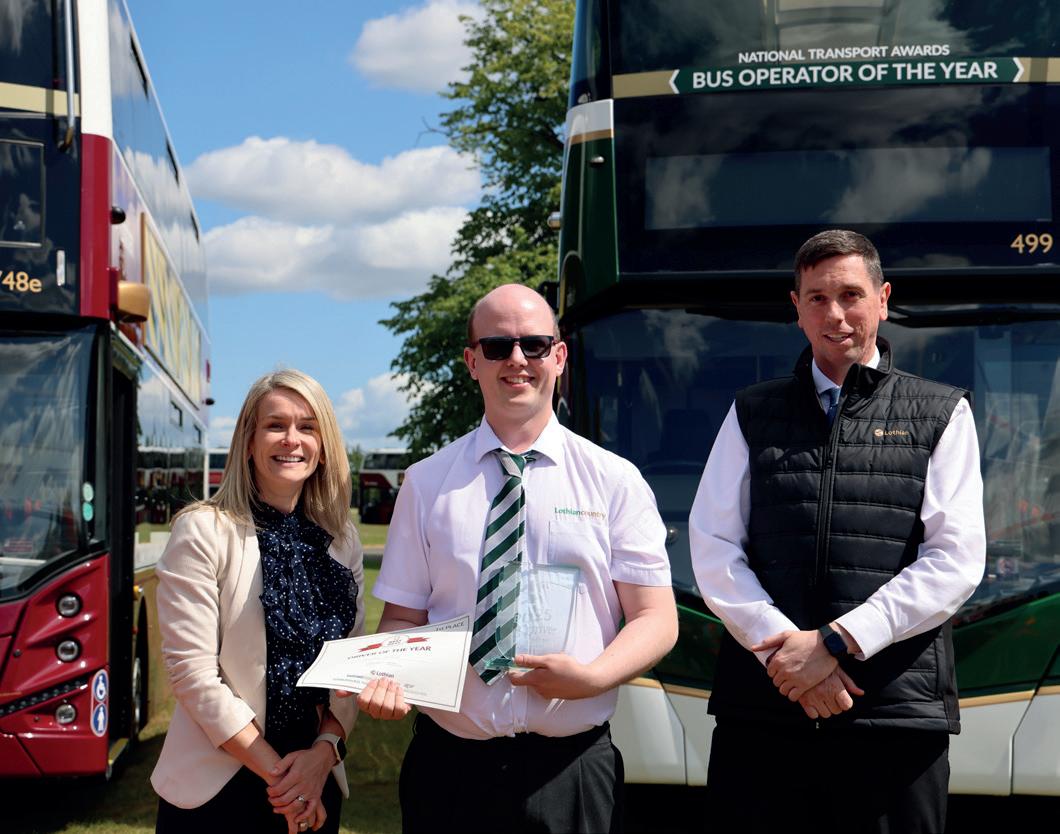

done before.”
The Scottish Government’s £500m Bus Partnership Fund, launched in 2019 with great promise, spent only a fraction of its budget before being replaced by the Bus Infrastructure Fund; however, the value of this fund remains unquantified. Last month, just £20m was allocated for 2025-26.
“We are where we are,” says Sarah. “There’s a commitment to deliver with the money that has been announced. Assuming that those projects can be brought properly to bear, I would say that should pave the way for a commitment for more investment.”
She points to a Midlothian project that would allow Lothian to reshape services and enhance the customer experience, particularly in Bonnyrigg.
“Examples like that make such a difference locally,” she says. “If you can make an impact on a group of people’s lives and either their travel patterns change or their experiences are just better

than before, to me that is what it’s all about, isn’t it?”
Such projects also help offset the growing impact of congestion.
“There’s no doubt that we’ve had to put in more resources in order to maintain our timetables,” says Sarah. “You’re basically putting in time, effort and investment just to stand still. I think there is a frustrating element to that.”
Lothian is tackling that challenge by improving network resilience; upgrading real-time information systems, enhancing its control room, and sharing data with partners to boost reliability.
Not all pro-bus policies have endured. In May, the Scottish Government dropped its pledge to cut car use by 20% by 2030, first announced in its 2020 Climate Change Plan. It now plans a new, jointly published policy with COSLA, setting “a successor target for car use reduction”.
“Anything that sends the message to people about modal shift, and about making those
'It’s

“What we’ve got now at Lothian is a really strong employment offering which attracts really good talent, and retains that talent. We wouldn’t have it any other way”
to reducing car use. So actually, for me, there’s still a conversation to be had around all of that. And those new and achievable goals are absolutely something that the bus industry can help to deliver.”
A role for bus franchising?
South of the border, momentum is building behind bus franchising. Greater Manchester has now completed the phased rollout of its franchised Bee Network, and other mayoral combined authorities in England are following. In Wales, the Welsh Government is committed to franchising all local bus services.
Is there a role for bus franchising in Scotland?
“I think there is a huge opportunity to learn from what has been done,” says Sarah. “It has been good to hear Scottish Government colleagues say that they are not necessarily looking to replicate what has been done elsewhere. The starting point is the cost of what has been done elsewhere. Is that actually truly possible to replicate and to sustain?
“What I think really is interesting is what franchising seeks to deliver. So if it’s everything from high frequency networks, quality fleet, good value for money fares, integration - all of these things I think can be delivered, if they’re not already being delivered, across our networks in Scotland.
“There’s a way to deliver the same thing potentially in a different way, but to still get really good results. It does need the willingness to work together and to really look at what would make a difference that would get people to then vote with their feet.”
intelligent travel decisions to use public transport as and when you can, is fundamental,” says Sarah. “And so there is a disappointment I would say in terms of that decision to drop the target.”
Even so, she remains optimistic: “The positive in it is the government has said they will now consult with the Climate Change Committee and look to set new and achievable goals. They are still committed
Recent years have seen a growing momentum to improve gender diversity in the industry. As a prominent figure in the UK transport sector, Sarah joined with others in 2023 to help launch the Women in Bus and Coach initiative.
With over two decades in the industry, starting in 2002 as a Graduate Trainee with Stagecoach, she’s seen progress but says more is needed.
“If you look at the Lothian numbers in terms of the number of women we now have with us, we have improved. There’s a higher percentage than there was,” she observes. “Do I still want it to increase again? Absolutely. So I think we’ve still got work to do, and I think that’s true for most companies.
“At certain levels in organisations I think things have really improved. It’s worth always breaking that down. When I say there is still work to do, for me that is at the driver level, whereas at our other levels we have been able to make far more progress.”
Recruitment efforts are now designed to encourage more women to apply — something Sarah sees as essential not just for equality, but for business success.
“Culturally, I think what you achieve with a greater gender balance is a better place for everyone. That’s what I’ve experienced.”
Coaches won’t be overlooked All of these issues will be discussed at this month’s CPT Scotland Conference in Edinburgh.
“It’s a great programme,” says Sarah. “It’s focused on shaping the future. There’s a strong mix of both urban and rural, and then the presence of both bus and coach.
“I think we’ll face into the many opportunities and challenges that the industry faces. I think it will be a really good, robust programme offering a real variety of opinion and thoughtprovoking pieces.”
Scotland’s coach sector will not be overlooked.
“I think there is a lack of recognition sometimes around the coach sector and the important part that it plays - both within Scotland’s economy and beyond,” says Sarah.
“We don’t have a coach strategy in Edinburgh and I think particularly over the summer months coach operators would be able to describe the challenges that presents.”
Integrating bus and tram
Sarah is energised by the opportunity to integrate Lothian Buses and Edinburgh Trams in her new role as Chief Executive. Her appointment follows City

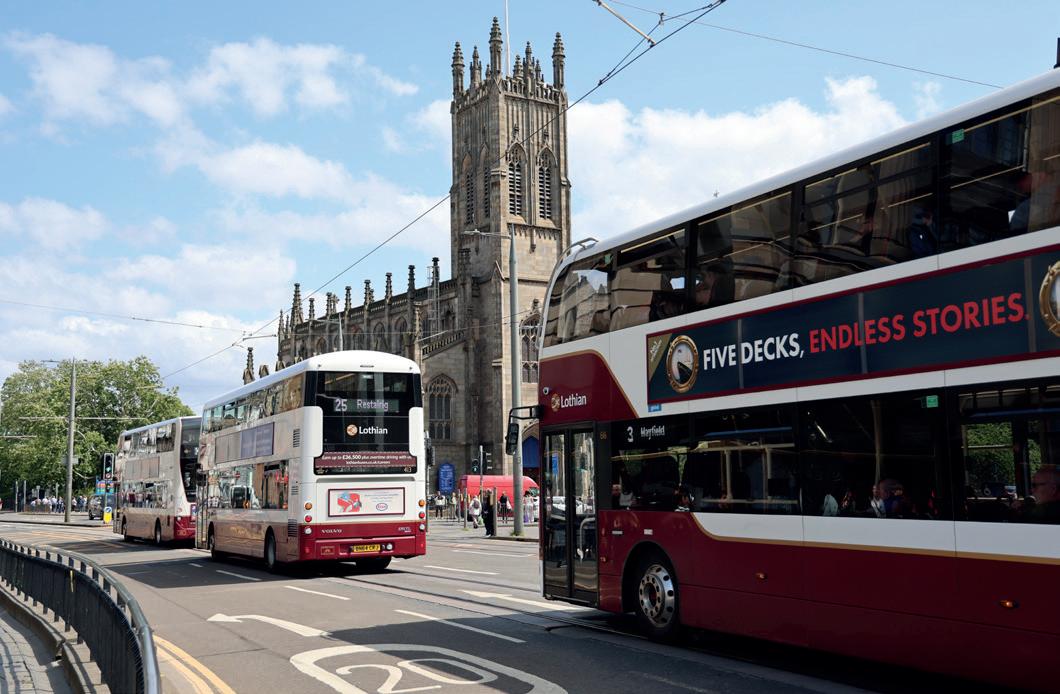
of Edinburgh Council’s 2020 decision to review the governance of its transport companies to create a more integrated approach.
She will now lead both organisations into their next phase, driving growth, fostering innovation, and realising the combined strengths of two awardwinning operators.
The changes will be formalised through an Integration Agreement between the companies, a key step toward closer operational co-ordination and an improved customer
“Culturally, I think what you achieve with a greater gender balance is a better place for everyone. That’s what I’ve experienced”
key interchange points will be assessed to make it much simpler to move between bus and tram.
“What is your experience on your wet, blowing-a-hooley day in Edinburgh?” asks Sarah. “That’s where that user experience definitely could be made better.”
She believes integration will also strengthen long-term decision-making: “I think having one voice feeding in at a strategic level will be really fruitful in the future, things like new big developments and having that public transport response.”
Tackling anti-social behaviour
Anti-social behaviour has become a growing issue in Edinburgh and beyond, deterring passengers and affecting staff.
Sarah says Lothian takes a zero-tolerance approach.
Years ago, it introduced TRiM (Trauma Risk Management), a peer-led support system developed by the Royal Marines, to assess and follow up with any team member involved in an incident.
experience.
“It’s very exciting, a huge opportunity, but it will take time,” says Sarah. “I do honestly believe that in time what we will achieve by joining up bus and tram will be greater than the sum of the two individual parts. We will get to that point, but as with everything absolutely there might be challenges along the way.”
Integration is already underway. In May, Scotland’s first multimodal, multi-operator account-based ticketing (ABT) system went live, linking Edinburgh Trams’ Tap-On, TapOff scheme with Lothian Buses’ TapTapCap. Passengers now benefit from daily and weekly fare capping across both modes.
Sarah wants to build on this: “For me it’s all about making it as simple as possible,” she explains. “Everything from the network, ticketing, information, the presence.”
Early attention will be paid to the airport presence, which is served by both bus and tram and
“Sometimes it’s the very small incident that is the straw that broke the camel’s back,” explains Sarah. “We now check in with everyone to make sure that there’s not a wider impact on them.”
Lothian also works closely with the police, deploying decoy buses and officers on services during peak periods such as Halloween and Bonfire Night. A new Youth Engagement Strategy, endorsed by Young Scotland, has also been launched.
To reassure customers, the company also promotes a friendly and respectful onboard atmosphere.
Sarah highlights progress by CPT Scotland and the Scottish Government on concession cards. Future users will be expected to follow a code of conduct.
However, Sarah is also keen to talk up the benefits of the free travel scheme for under-22s, which was introduced in January 2022. “It’s an incredible scheme,” she says. “It’s enabled so many good changes in travel patterns for young people, hopefully now instilling a whole generation of people that just naturally will travel by bus. That is absolutely to be celebrated.”
The road to zero-emission Decarbonisation remains a major challenge for Lothian and other operators. The company became fully Euro 6 compliant in 2022 and will have 98 new electric buses by year-end, making over half the Central depot fleet electric. Several open-top tour buses have also been repowered from diesel to electric. A full zero-emission transition, however, remains some way off.
“We’ve not set a no more diesel purchase target,” Sarah explains. “I think we will be able to in the next couple of years. But actually, I think there is a real possibility that, for the outlying parts of our business, when you think about us running a vehicle for 12 to 14 years, there’s a good chance that we will still need to invest in diesel for those parts of the network.”
She adds: “It’s got to be done in an efficient way. The reality of the length of some of our running boards is that there is no way around it; you’d have to bring the bus in for a charge, or have more vehicles in the cycle. There are still questions that we can’t quite answer.”
The new electric fleet has been well-received, offering a smoother and quieter ride, as well as features such as dementia-
friendly flooring, which enhance the customer experience and encourage more people to choose the bus.
improvement
Last year, Lothian expanded with the acquisition of East Lothian coach operator Eve Coaches, but Sarah says the focus now is on strengthening existing services.
“We wouldn’t want to go too far, too fast - particularly because of costs,” she explains. “We want to get better at what we already have, but never say never because opportunities come along.”
Improvements will include clearer information. While Lothian’s new customer app combines tickets and info, it currently differs from on-street signage, and the company is working with City of Edinburgh Council to better align them. Better updates during disruption are also a priority.
“We are 105 years old, 106 nearly, and we’ve always been evolving,” says Sarah. “I think there is a really strong culture at Lothian of continuous improvement … We’re always adding. That’s what makes this organisation amazing. You’ve got nearly 3,000 people who care. That is the bit that binds us all together.”
Attracting talent
Engineering is a major focus for Lothian. With the sector short of engineers, Sarah says the company’s long-running apprenticeships scheme has provided an invaluable source of home-grown talent.
“We’ve got engineering apprentices who are coming towards the end of their time and we’ve got jobs coming up within the business,” she explains.
But she is keen to go further to expand the pool of talent available to the company, especially women.
“For me, there’s still a piece of work locally to get into the minds of young people that we would be an employer that you would
“The new electric fleet has been well-received, offering a smoother and quieter ride, as well as features such as dementiafriendly flooring, which enhance the customer experience”
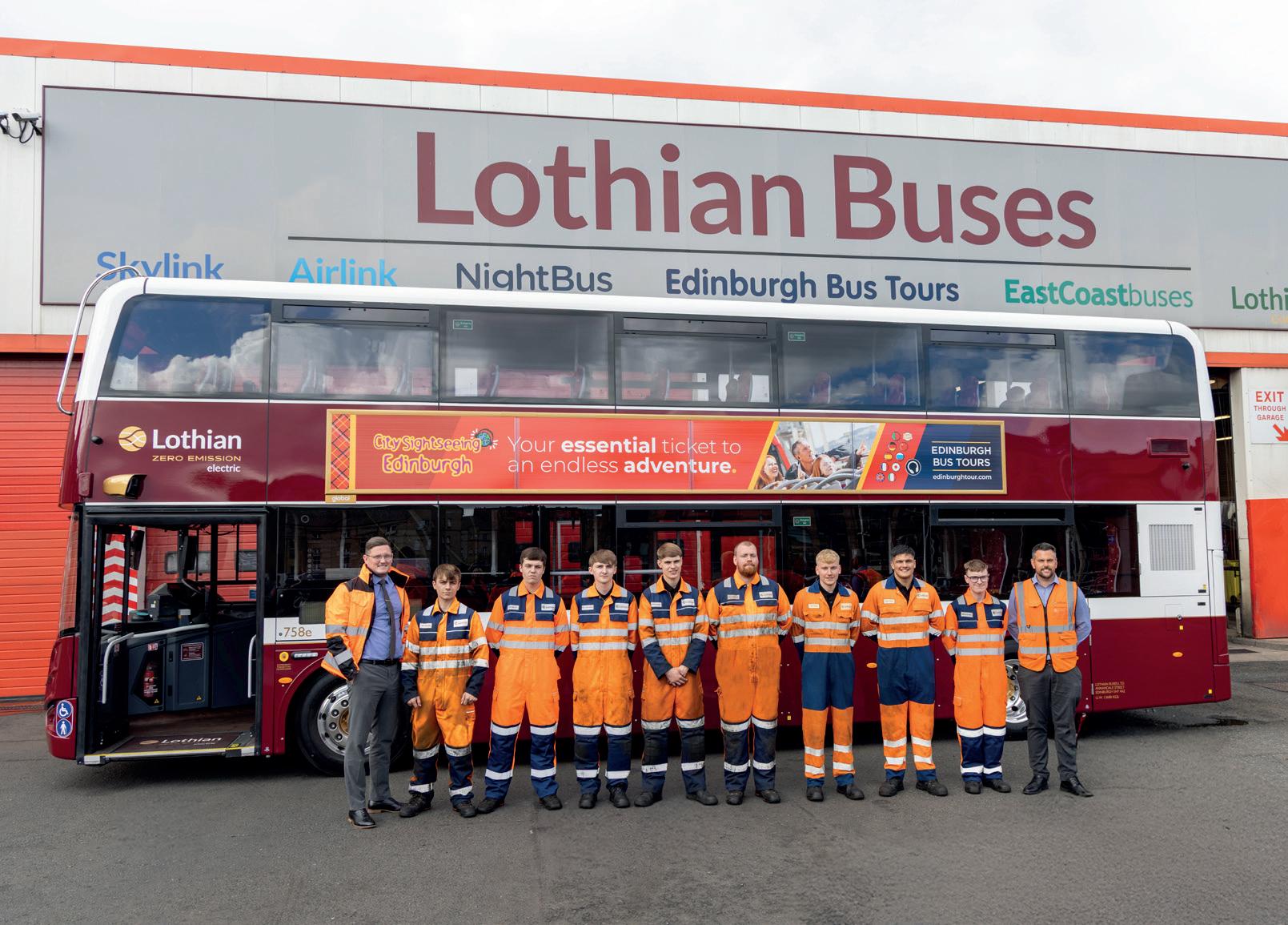
want to come and work for,” Sarah adds. “The old-fashioned, ‘you have to lift a wheel’ days are gone. You don’t have to be strong to work in our engineering team any more.”
She highlights the benefits of long-term careers at Lothian: “We’ve got so many people whose career stories are that they came here for six months and 25 years later they’re still here. I think it would be great to have people come here and plan to stay to really develop their career for the longer term.”
Sarah stresses the power of word of mouth. “We all joke about it being two degrees of separation in Edinburgh to someone who works at Lothian,” she adds.
“So I think there is real power in knowing someone that works here and that person thinking it’s a brilliant place to be.”
She also wants to celebrate internal progression. “What binds us together is our real care and passion for delivering a great service,” she says. “I think what we need to do more of is get that across to people: if you have that attitude and continually want to improve yourself and what we are doing collectively, that this really is a great place to be.”
From a personal perspective, Sarah says it’s a “massive privilege” to lead the company she joined 12 years ago as Head of Operations.
“It took a lot to leave Stagecoach but there was no question that Lothian was a company I wanted to join,” she says. “So I guess having risen up the ranks of Lothian, it’s a massive privilege to lead such a great team of people, and I do still get up every day and have such enthusiasm for what I am doing.”
It hasn’t always been easy, and Sarah says there have been times when she has fallen out of love with the job, but there are huge rewards in watching the progress being made.
“You don’t have to go too far at Lothian to find that,” she says. “It’s not all big and bold and obvious. It can just be the days of standing on Princes Street watching what’s happening during the Festival, or being out with the team during the Oasis concerts. I just have a huge passion for what I get to do every single day.”

A look back at the last year A selection of key events for
since last year’s
Lothian named National Bus
The National Transport Awards 2024 in London in October was an impressive evening for Scotland’s transport operators. Lothian Buses clinched the prestigious UK Bus Operator of the Year award, while McGill’s Bus Group was recognised for providing the Best Bus Service with their Glasgow Nightbus.
Sarah Boyd, Managing Director of Lothian said: “I am absolutely delighted that Lothian have been recognised as Bus Operator of the Year at the National Transport Awards.
“Our people make Lothian
a great place to work, and this award is a testament to their hard work and dedication to ‘getting it right’ in delivering for our customers on a daily basis.
“This award belongs to them, and I would like to take this opportunity to thank every one of our people for their passion, commitment and loyalty.”
Lothian driver Thomas Fair was also highly commended in the Frontline Employee category for his fast actions when a customer went into labour on his bus.
‘Big small bus’ for Ayrshire
Stagecoach West Scotland unveiled its fleet of 12 world-first electric midibuses in October.
The £5m investment saw the introduction of a dozen electric midibuses (Enviro100EV) for East, South and North Ayrshire, boosting the total Stagecoach electric bus fleet across Ayrshire to 60 vehicles.
The midibuses, assembled in Scotland by Alexander Dennis, are the first of this vehicle type to be used anywhere in the world.
Local communities are benefitting from these smaller EV buses which are not only emission free but are nimble enough to travel through areas that larger buses cannot.
The Enviro100EV is an innovative design which has been crafted in collaboration by Stagecoach with Alexander Dennis and fills a crucial niche for shorter wheelbase EV buses
on routes that cannot be easily served with larger buses to further enhance connectivity within Ayrshire communities.
In January, the Highland Council announced it has completed detailed negotiations to acquire D&E Coaches, northern Scotland’s largest independent coach and minibus operator, in a strategic move to expand its nascent in-house bus operation.
The council launched its municipal transport business in January 2023, and by last summer,
councillors were informed that the initiative had proven both cost-effective and reliable, delivering significant financial savings on council bus contracts. The acquisition of D&E Coaches marks a significant step in scaling up the operation.
“The acquisition of the company will enable the council to accelerate the provision of public transport services in the area, achieve operational cost efficiencies and reduce the risk of future contract cost increases,” The Highland Council said in a statement.
Founded in 1996 by Donald and Elizabeth Mathieson, D&E Coaches started with a single minibus and has grown into a well-respected operator known for its reliability, quality service, and strong community ties. At the time it was acquired by the Highland Council, the company operated a 60-vehicle fleet, providing private hire, school transport, event shuttles, and tourism services.
First Bus in the Strathclyde Partnership for Transport region achieved the highest rating of Scotland’s bus operators in Transport Focus’s Your Bus Journey, which was published in March. Almost nine out of 10 of the people (89%) who used the company’s services said they were either ‘satisfied’ or ‘very satisfied’ overall.
This was followed by McGill’s Bus Service (88%), Lothian Buses (85%), Stagecoach in Nestrans (84%), Stagecoach in Tactran (83%), Xplore Dundee (82%), First in Nestrans (80%), Stagecoach in HITRANS (79%) and Stagecoach in Swestrans (79%).
Similarly, 86% were satisfied is the journey time was as expected, but this fell to 55% if it was longer than expected
The owners of McGill’s Bus Group expressed concerns over the cost of bus franchising in Manchester in March, warning that the £226m annual cost should be a consideration for Scottish politicians as they explore similar plans.
Sandy and James Easdale pointed to new Transport Focus bus satisfaction statistics, which suggest that overall satisfaction in Greater Manchester, which was only part franchised at the time, declined between 2023 and 2024, ranking 36th out of 39, down from 27th the previous year. By comparison, they pointed out that Strathclyde bus services were ranked the highest in Scotland,
with a satisfaction rating of 88%.
The Easdales highlighted the ongoing discussions about bus franchising in Strathclyde and cited budget documents from the Greater Manchester Combined Authority outlining the financial commitments associated with the Bee Network. They argue that similar franchising in Strathclyde could lead to an annual cost to the taxpayer of £400m.
“It’s been less than six months since Andy Burnham swaggered up here, claiming he was the allknowing bus guru who could help bring franchising to Strathclyde,” said Sandy Easdale.
“But what he conveniently failed to mention was the colossal £226m annual price tag dumped on taxpayers in Greater Manchesterall because he wants to tighten his grip on public transport.
“No politician - not one councillor, MSP, or government minister - can now claim ignorance over the true cost of this madness.”
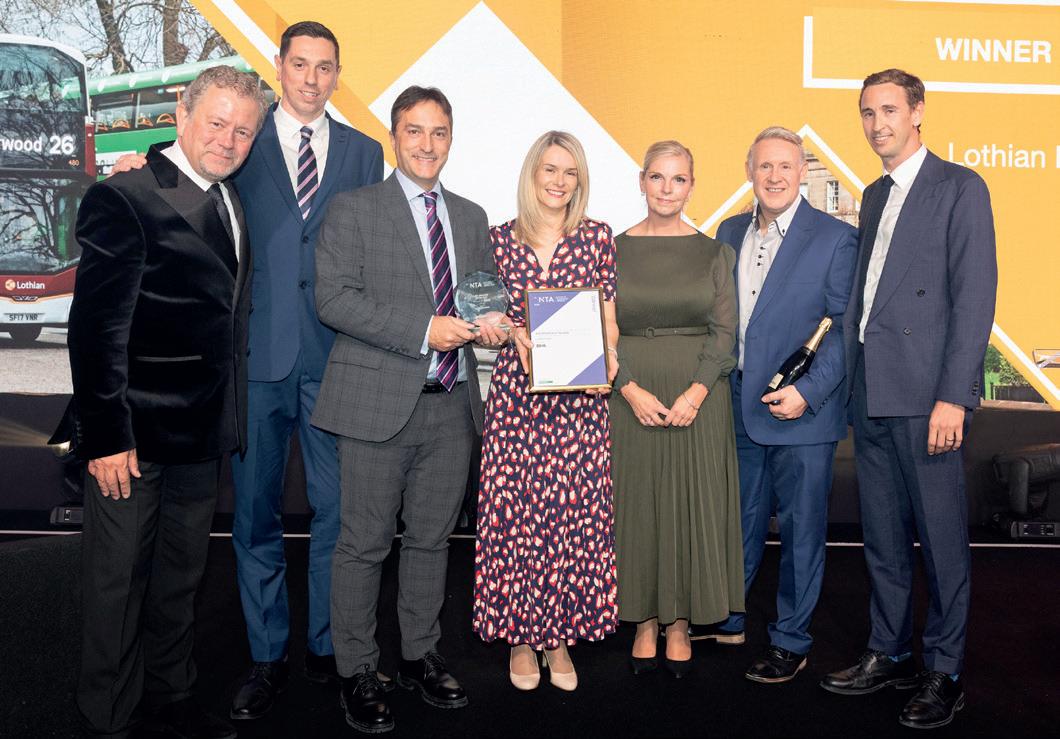
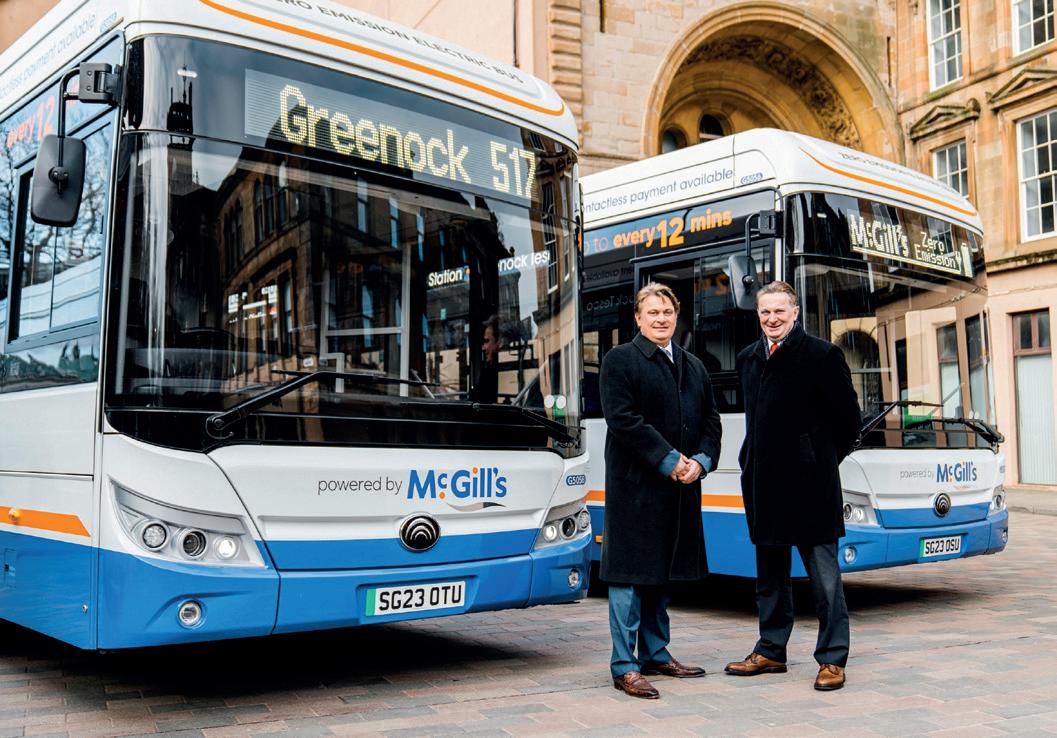
Zenobe, a leading provider of vehicle fleet electrification and battery storage innovation, demonstrated the deployment of Scottish Zero Emission Bus Challenge Funding (ScotZEB) during a visit in March by Fiona Hyslop MSP, Scottish Cabinet Secretary for Transport, to the McGill’s Xplore Dundee bus depot.
At the Dundee depot, Zenobe had deployed ScotZEB 2 funding to support McGill’s with the rollout of 12 Yutong U11 double-deck electric buses and the installation of six 120kW Zerova chargers.
In March, Stagecoach East Scotland introduced 13 new Volvo 9700DD double-deck coaches on its X24 and X27 Glasgow Express routes, connecting Leven, Kirkcaldy, Cowdenbeath, St Andrews, Glenrothes, Dunfermline, and Halbeath Park & Ride with Glasgow.
Soon after the the new fleet launched, the operator reported an increase of 4,000 extra journeys, with positive customer feedback. Scott Hall, Stagecoach East Scotland’s Head of Commercial, described the patronage boost as “great to see” and hoped the trend would continue.
March also saw the results of a survey of 1,283 bus users in Scotland were published by Transform Scotland. The findings emphasised the need to punctual services with fast journey times. 89% were satisfied if the wait time for the bus was as expected, but this fell to 63% if it was longer than expected. The owners of McGill’s expressed concerns over the cost of bus franchising
In May the Scottish Government dropped a key climate change target to cut car use in Scotland by 20% by 2030.
The commitment had been included the Scottish Government’s Climate Change Plan update back in 2020. Half a decade later, the Scottish Government’s programme for government statement revealed the target would be replaced. It committed the government to
publishing jointly with COSLA (Convention of Scottish Local Authorities) “a renewed policy statement on reducing car use in Scotland, which will set a successor target for car use reduction aligned with the development of the draft Climate Change Plan”.
The government will work with COSLA and regional transport partnerships “to develop delivery plans for car use reduction, reflective of different communities and places”.
Steven Stewart, who was Director of Corporate Communications at Stagecoach Group when the 20% target was introduced, said the decision to scrap it “felt as depressing as it was predictable”.
He added: “The decision this week to abandon such a key climate change target is a car crash made in Scotland. But you’ll easily find similar examples nationally at UK level and in local government, whatever party is at the steering wheel.
“Electoral promises made. Weighty strategy documents published. Job done.
“A lack of leadership. A failure to act. Crises worsening.”
Stewart concluded: “The Scottish Government ambition wasn’t wrong. What’s missing is the political will to make it happen and the need to focus our resources on actions, not words.”
Scotland’s first multi-modal, multi-operator account-based ticketing (ABT) system was unveiled in Edinburgh in May, offering seamless bus and tram travel across the city for residents and visitors.
A newly launched Edinburgh Trams ‘Tap-On, Tap-Off’ (‘ToTo’) ticketing and payment scheme, developed by transport technology specialists Flowbird, was integrated with Lothian’s existing TapTapCap system, heralding a new era of transport connectivity. As a result, fares for single mode journeys or combined bus and tram travel across the city will now benefit
from daily and weekly fare capping rules.
The new payment environment enables passengers to switch easily from tram to bus, and vice-versa, and be sure to receive the best available fare for their entire journey. The only difference in the customer experience is that while Lothian operates a flat fare ‘tapon’ only system for city services, the zonal fares structure for trams means that users need to tap-on and tap-off.
First Bus took home Public Transport Operator of the Year at June’s Scottish Transport Awards in Glasgow. The prize was in recognition of its significant investment in digital innovation, fleet upgrades and customer
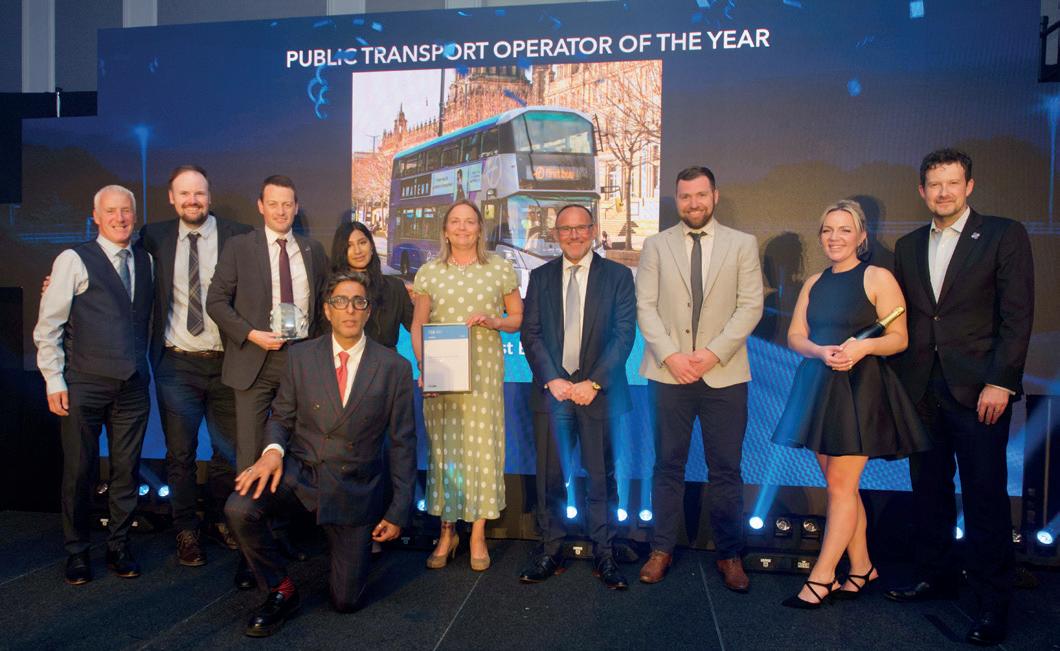


engagement. The operator also won Excellence in Technology and Innovation for its AI-driven timetabling system, which has improved punctuality and network efficiency across Glasgow.
A focus on community impact was evident in the recognition of Lothian Buses and Police Scotland, who won Excellence in Social and Community Value for Operation Crackle, a collaborative effort to reduce anti-social behaviour and create safer public transport environments. Lothian also won Best Bus Service for Lothian Country Service 43.
In the realm of sustainability and innovation, Zenobe’s ScotZEB2 consortium was named Most Innovative Transport Project of the Year for its largescale rollout of electric buses and charging infrastructure in partnership with multiple operators.
Stagecoach West Scotland announced in June that it would significantly scale back its operations in Dumfries & Galloway, ceasing the majority of its services in the region following the outcome of a local authority tender process.
From early August, Stagecoach would operate only two routes in the area: the X74 service between Dumfries and Glasgow, and Route 79 from Dumfries to Carlisle, which will be managed from the company’s Carlisle depot under Stagecoach Cumbria and North Lancashire. The decision would also lead to the closure of Stagecoach depots in Dumfries and Stranraer.
The move came after the operator was unable to agree to the terms set out in Dumfries and Galloway Council’s latest tendering round for 45 subsidised routes. Stagecoach said a liability clause within the new contracts was “far in excess of the value of the contracts on offer,” rendering its bids non-compliant.
As a result, the company also withdrew most of its commercial services in the area as a result of the tender losses making these
routes unviable. Affected services included several Dumfries town services, plus connections to Lockerbie, Castle Douglas and Cumnock.
The future of Alexander Dennis’s bus manufacturing operations in Scotland was secured in September 2025 following a rescue package brokered after months of tense negotiations.
The Canadian-owned company confirmed that its Larbert and Falkirk factories will remain open, protecting hundreds of skilled jobs that had been at risk of redundancy. Up to 400 jobs were on the line, with ADL understood to have even put its Falkirk site up for sale as part of plans to consolidate manufacturing at its planned sole remaining UK facility in Scarborough.
The breakthrough was made possible thanks to a £4m Scottish Government-backed furlough scheme that will safeguard roles needed to maintain production capacity. The six-month scheme will buy time while ADL secures new orders for its single and double-deck buses, which the company claims are showing strong signs of increasing demand.
Despite the scheme for manufacturing staff, ADL said that to improve its competitive position, it has confirmed it intends to propose further changes to its business structure, with expectations that 11 roles not directly linked to Scottish manufacturing remain at risk of redundancy in the ongoing statutory consultation.
Scottish First Minister John Swinney announced the deal during a visit to ADL’s Larbert site, where he addressed workers and union representatives.
“The Scottish Government wants to retain the manufacturing workforce of Alexander Dennis,” he said. “This agreement is intended to act as a bridge to a sustainable future for the company in Scotland.”
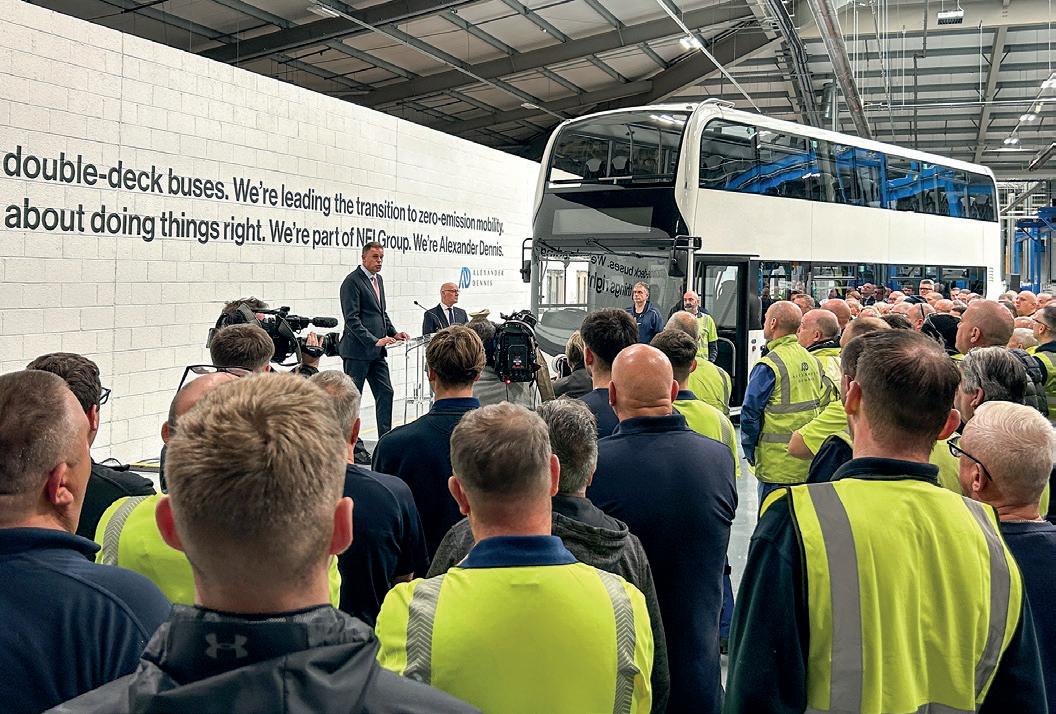

In September, McGill’s Group has unveiled plans for a £25m depot on a prime site in Glasgow, positioning the UK’s largest independent bus operator for expansion as Strathclyde
Partnership for Transport (SPT) advances plans for bus franchising.
The company has confirmed it has completed the acquisition of a 6.55-acre brownfield site on Kilbirnie Street in Tradeston, 1.5 miles south of the city centre. The location offers space for up to 300 vehicles, giving McGill’s both a modern operational hub and significant headroom to expand its fast-growing coach fleet alongside its core bus operations.
With franchising on the political agenda, the depot strengthens McGill’s credentials as a serious contender for future contracts, despite vociferous condemnation of the plans to reregulate the region’s bus services
priority signals, upgraded stops and transport hubs. It is part of the Scottish Government’s wider efforts to grow the economy, tackle the climate emergency and improve public services, while encouraging more people to choose buses over private cars.
Jim Fairlie, Scotland’s Minister for Agriculture and Connectivity, said the fund would make journeys faster and more reliable, making buses a more attractive option. “Time is everything,” he said. “If it still takes longer to get to your destination than by car, the bus simply can’t compete. This investment will help transform that.”
Projects will be funded through two tiers. The first will see £10m distributed to all local authorities on a per-capita basis, with more going to areas experiencing “transport poverty”, particularly rural regions and deprived communities. The second tier, also £10m, will support largerscale bus partnerships, funding design and construction work on corridors into major cities such as Glasgow, Dundee and Edinburgh.
by McGill’s owners Sandy and James Easdale.
“This project is not only about our own growth - it’s about creating up to 850 jobs and driving further regeneration in this part of the city,” said Sandy Easdale. “Tradeston is the ideal location, offering superb motorway and public transport links, staff facilities already in place, and the space we need to support both our bus and our fast-growing coach fleets. And this is just the start - further strategic deals are already in the pipeline, both in company property and for the expansion of McGill’s operations.”
In September, the Scottish Government announced allocations worth £20m for the Bus Infrastructure Fund for 2025-26. The fund will support a range of projects including new bus lanes,
The programme has been welcomed by operators and industry groups. Graeme Macfarlan, First Bus Scotland’s Commercial Director, said investment in priority measures was “a win-win for customers and all road users by reducing traffic and congestion through more people switching to bus travel”.
McGill’s Group subsidiary Midland Bluebird launched 30 new zeroemission Yutong E12 electric buses in September, part of a £14m investment that has received support from the Scottish Government’s ScotZEB scheme.
The Yutong E12 single deckers can carry up to 70 passengers and feature full air conditioning. They have been introduced on Midland Bluebird’s flagship Route 38 service linking Falkirk and Stirling, which has also seen frequencies improved during daytimes to every 15 minutes.
The rollout takes McGill’s electric fleet in Scotland to 151 buses.

uses and community transport are not a luxury in rural Scotland - they are a lifeline. They enable access to education, jobs, health services, and social opportunities. Yet the current funding model for bus services leaves rural and island communities at a systematic disadvantage. Local government finance is under severe strain, and discretionary spending such as supported bus services is suffering most, whilst the population
density and geography mean few services have the potential to be commercial. The consequence is clear: the people who rely most on public transport are the ones most likely to be left without it.
For more than a decade, councils have faced eroding budgets. With statutory services like education and social care taking priority, discretionary areas such as supported bus services are squeezed. By 2019, Scotland had lost over 20% of its subsidised local bus services, with around 60 routes disappearing. Rural areas
have borne the brunt, because in places where no commercial operator exists, withdrawal of support usually means withdrawal of service.
This erosion of provision is not a small inconvenience. In the Highlands and Islands, where distances are great and alternatives limited, loss of a bus service can mean losing access to a GP, missing opportunities for education or training, facing isolation from community life, or enforced car ownership. The challenge is not simply about transport - it is
about fairness and opportunity. Government intervention in transport has tended to favour urban networks. The National Concessionary Travel Scheme (both over 60s and under 22s) and Network Support Grant (NSG) funnel greater financial benefit to areas with frequent, commercially viable services. The Under 22 scheme illustrates this disparity most starkly. Between January 2022 and May 2023, government spending per young person in Edinburgh reached £356 through the scheme. This compares with a per cardholder spend of just £47.37 in Orkney and £41.67 in the Western Isles. These differences reflect not entitlement in principle but opportunity in practice. Young people in Edinburgh can make dozens of journeys each week at no cost; in parts of the Highlands and Islands there are no bus services at all or a very infrequent service. Even more telling is uptake in

the same period. In Edinburgh, 93% of eligible young people hold and use the Under 22 card, while in the Western Isles the rate is closer to 50%. Taken together, the result is that the benefit delivered to young people in Edinburgh is almost twenty times greater than that available to their peers in the islands. This is not just about the capital city. The disparity is repeated in other large urban areas. And even this limited island usage can be misleading. A significant proportion of concessionary card use by island residents occurs not in the islands themselves, but when students are studying on the Scottish mainland. The net effect is that central government expenditure continues to reinforce the strength of urban bus networks, while contributing little to sustaining fragile services in the islands.
HITRANS's 2021 report, Rural Bus Service Support and FundingCase for Change, set out practical
“Scotland has ambitious goals on reducing car dependency, achieving net zero, and tackling rural depopulation. None of these will be met if rural and island communities are left behind in transport policy”
steps to redress this imbalance:
n Dedicated rural transport fund: A ring-fenced long term fund for lifeline rural and island services.
n Network Support Grant (NSG) top-ups for rural services: Modify NSG so that services in remote areas receive additional support.
n Capital and infrastructure Investment: Restore and expand rural transport infrastructure grants.
n Support for DemandResponsive Transport (DRT): Flexible and on-demand solutions can transform connectivity in remote areas. In the HITRANS region, the MOOVE Flexi app provides an easy-to-use digital booking and scheduling platform that has modernised DRT services. It also powers m.connect in Moray whose enhancement is pump primed through the regional growth deal.
n Fleet modernisation: Ensure that rural operators are supported in transitioning to low- and zeroemission vehicles.



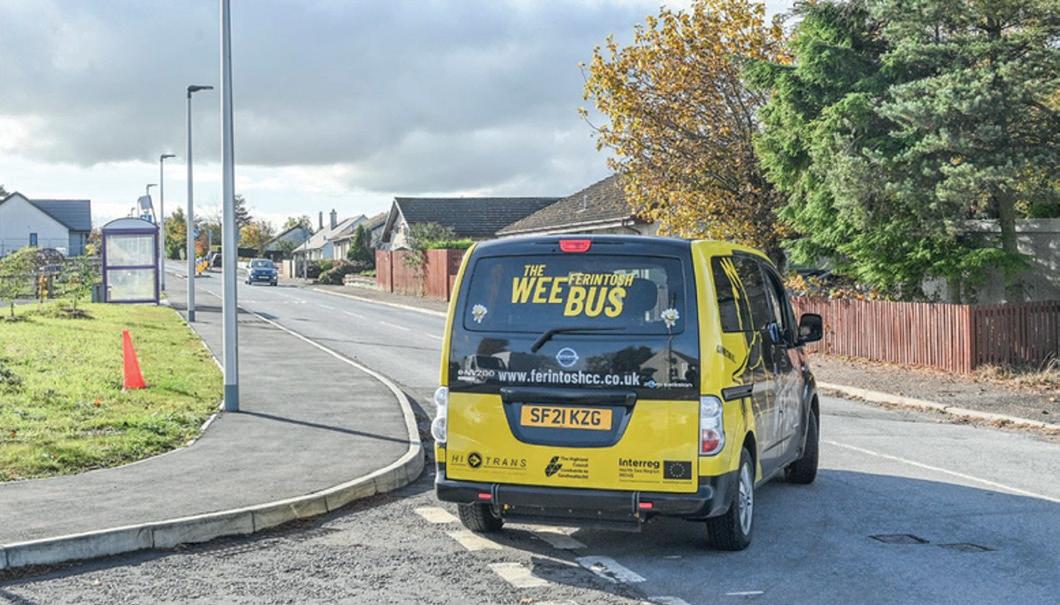
n Regional Collaboration: Strengthen the role of Regional Transport Partnerships to coordinate across our geographies. Scotland has ambitious goals on reducing car dependency, achieving net zero, and tackling rural depopulation. None of these will be met if rural and island communities are left behind in transport policy. The current model entrenches inequality by favouring urban networks where buses are commercially viable. A recalibration is overdue. National schemes should deliver equity, not reinforce advantage. Rural and island services need to be recognised as essential infrastructureworthy of the same level of security and ambition as their urban counterparts. By adopting the recommendations of the HITRANS Case for Change report, by backing successful innovations such as MOOVE Flexi and m.connect and working with communities on place-based solutions, we can deliver fairness, inclusion, and sustainability. But digital technology alone is not the answer there needs to be revenue support for the operations. Transport should be about equity as much as efficiency.
For rural Scotland, it is time to value the huge potential of our rural economies on which so much of Scotland’s future growth depends. We need to take people to work in renewable energy, aquaculture, food, drink and tourism and like in cities we should aim to increase the number of people able to get there on sustainable modes of travel.
Towards the end of 2023, at the South East Scotland Transport Partnership (SEStran), we began working on our regional bus strategy. We’re made up of about a third of Scotland’s population across eight local authorities, and the economic and social opportunities of our region are plentiful. So we need a bus network worthy of our region, which can meet and facilitate growing numbers of people and houses, can connect communities and which offers a viable alternative to car ownership and use.
We have a lot going for us here: long-standing and well-respected bus operators, committed and hard-working local authority public transport teams and a regional transport strategy committed to a better South East Scotland by 2035. But there are also significant challenges around bus:
n Some areas of our region have little to no service, in particular to support evening and weekend journeys;
n Fares and tickets are complex and can be off-putting for potential new users;
n The network is shrinking year on year, in both geographical range and patronage.
Add to this worsening congestion, particularly in our cities and towns, and you can see the need to set a new course.
We have a vision for where we want to go: To provide a high quality, affordable, accessible and available bus network for the whole region which is fully integrated with other forms of transport and increases passenger numbers and passenger satisfaction, to support

“We had a fantastic response to our public consultation - during the course of a month we received more than 5,000 responses”
the social, environmental and inclusive economic development of the region.
To achieve this bold ambition, we’ve decided to focus on three key pillars:
1
Level of service
This policy area will consider how, where and when the bus network operates. For example, it will set out ambitions for the hours of operation of bus services, how frequently buses run, and the connectivity the bus network needs to provide in order to widen opportunity and decrease car use across the rural and urban landscape of the region.
Focussing on these three core areas has already proven effective. We had a fantastic response to our public consultation - during the course of a month we received more than 5,000 responses, as well as informal responses via email and social media platforms. Key insights from that work include:
Top reasons for avoiding or being unable to complete bus journeys:
n Infrequent services (59.3%);
n Poor connections (56.2%);
n Indirect routes (51.4%);
n No buses at needed times (51.4%);
Affordability challenges:
n 23.2% of respondents have avoided using the bus due to high costs.
Most desired affordability improvements include:
n Simple fares (35.7%);
n Automatic best-value pricing (33.1%);
n Discounts for young/lowincome groups (28.2%).
Ticketing confusion:
n 36.6% have been unsure if their ticket is valid across different services;
n 14.2% have avoided buses due to confusing ticketing.
Top safety issues include:
2
Affordability
The policy will set out ambitions related to the affordability of bus travel across the region, including factors such as the structure, legibility and integration of fares.
3
Service quality
The policy will focus on the other important aspects that allow the delivery of a high-quality bus service. This includes considerations such as interchanges and bus stops, accessibility, information, ticketing, vehicle and driver standards, and service reliability and punctuality.
“Across the UK, we can see examples of regions and communities waking up to what a powerful tool bus can be”
n Fear of crime/anti-social behaviour (51.4%);
n Poor lighting (33.1%);
n Isolated stops (25.2%).
Accessing the network:
n 65.3% of respondents said easy access (low floors, ramps, wheelchair spaces) is one of the most important features when travelling by bus;
n At bus stations, accessibility was also a priority: 45.1% selected it as one of the top five valued features.
Across the UK, we can see examples of regions and communities waking up to what a powerful tool bus can be in fostering connection and economic opportunity. As we come towards the publication of our regional bus strategy at the end of this year, it could be easy to see this as the end of the process, but it is of course just the beginning. Realising this new future will require ongoing collaboration, innovation and support from local, regional and national government, as well as the operators who keep the network alive.
Last year, almost 168,000 works of different types took place on Scotland’s roads. These ranged from small works to install new broadband connections, all the way up to large sewer replacement schemes. They also included works by councils to maintain and improve their road networks. These are of course, all essential works. We could not live in the modern society that we do without reliable access to these services, or without the road network that we all rely upon.
Now, as a road user, I would be the first to acknowledge that these works, by their very nature are disruptive. How else could works that block roads and footways be described? That said, the vast majority take place without incident and with a minimum of impact on both road users and residents. A small minority of works do, however, cause significant disruption. These are not always found in city centres; works at remote rural locations can be equally problematic.
Organisations carrying out road works have a legal duty to work safely, minimise disruption and protect the integrity of the road.
Working together
My role is not only to ensure that organisations carrying out road works meet their legal obligations, but also to promote best practice in the industry. I work closely with both councils and utilities to find ways to improve the planning and delivery of road works in line with their legal duties.
Over the last year, and thanks to both CPT and members of the
wider bus operator community, I have been given a renewed appreciation of the impact that road works can have on bus and coach services. Given the key role that your industry plays in achieving Government’s net zero ambitions, I think it is especially important that we find a way to minimise the effects road works have on bus and coach sectors. I fully appreciate the difficulty of your task to persuade drivers to make the switch to bus and coach services; these must be both reliable and punctual to make this an attractive choice.
This year, my team has focussed on work to better understand use of emergency and urgent works by the road works industry. Feedback from your sector is that these works, which make up around 18% of works overall, are especially problematic to bus

Kevin Hamilton
“There is an increased recognition amongst the road works industry of the impact of works on bus services”

operators. Whilst the picture is substantially better than that in England, where around 40% of works are unplanned, it is my desire to minimise these.
Work is also underway this year to make changes to the Scottish Road Works Register. This database of road works is used by councils to coordinate works, but until recently this did not have information on bus services and infrastructure, meaning that the job of the council was made harder than it should be. By the end of 2025/26, I aim to have added both the location of all bus stops and bus route information, making it easier for everyone involved in road works planning to understand the potential impact of works on bus services.
There is an increased recognition amongst the road works industry of the impact of works on bus services. Updates to the industry Co-ordination Code of Practice will place an increased emphasis on councils and utilities to consider bus services when planning and carrying out works. Improved consultation with operators is also being promoted as part of this.
Thanks to CPT, I have visited and been very impressed to see the operations of CPT members. It is clear that there is considerable work and resource that goes into adapting and amending services to react to road works. There is also much evidence of good practice between councils and operators. I believe that close liaison between both is key to securing the best possible outcome for service operators and users. In my view, fostering of closer links is not only the first step, but potentially the most effective one to minimise the impact of road works on services. There will always be a need for works on our roads. Regrettably, there will also be delays and inconvenience caused by these. However, by working together these can be kept to the absolute minimum.
I look forward to working with CPT over the coming year and remain confident that, through working collaboratively, our two sectors can deliver positive improvements that help everyone.
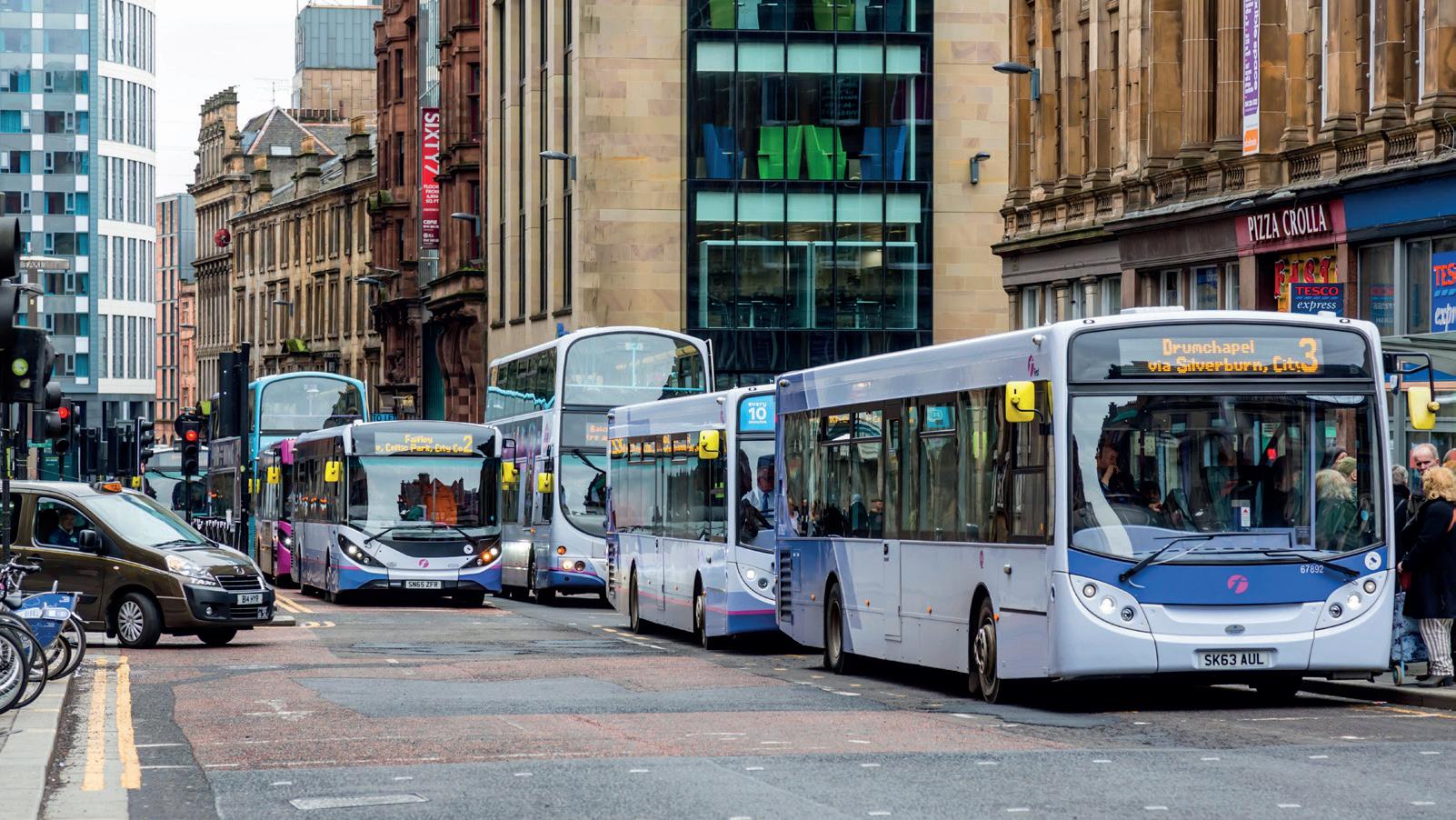
Unite represents thousands of bus drivers and platform staff across Scotland and our primary task on behalf of our members is to help drive up the standard of jobs, pay and conditions.
We proactively work with bus companies daily to improve the quality and level of service provision, and while we do not always agree, there is often a shared understanding that we need to work together in the interests of bus drivers and passengers.
The issue on which there is perhaps the greatest shared common goal is the protection of bus drivers and platform staff across Scotland. Last year, Unite launched our ‘road map’ which lays out a series of concrete steps which we believe could immediately improve the safety of bus workers across Scotland.
We launched the road map in the aftermath of Keith Rollinson’s death, a member of Unite, following an assault at his place of work in Elgin. It was clear to
us as a trade union, and to many bus companies, that greater efforts were necessary to discourage anti-social and violent behaviour on buses.
The road map is designed to promote consistent practices across Scotland. It includes increasing the presence of police officers or community wardens on buses, CCTV coverage on buses and at bus stations, panic buttons and other enhanced safety features installed on buses including internal locking systems.
In November 2024, Unite released the findings of a mass survey of 1,100 bus drivers across Scotland. The mass survey found that:
n 84 per cent said the number of instances of abuse at work increased in the last 12 months.
n 83 per cent of victims of abuse said it was verbal, 16 per cent said it was physical, and one per cent said it was sexual abuse or assault at work.
n 79 per cent said the abuse was not reported to the police while 48 per cent did not report it to their employer.
Behaviour stakeholder group being set up, which includes unions, bus operators, the Scottish Government, Police Scotland and Local Authorities.
We’ve also met Government Ministers and held round table meetings in the Scottish Parliament with all political parties to raise our concerns.
Bus operators have changed their conditions of carriage to allow greater action to be taken against persistent anti-social behaviour offenders, and there are many examples of passengers being banned from traveling on buses. Protective screens, better door locks in drivers cabs and increased messaging on buses have all been delivered across all major operators.
The Scottish Government have also indicated the withdrawal of the free travel pass where necessary, and this is a major shift which will come into effect in 2026. Police Scotland are similarly committed to playing their part with increased presence of officers and faster response times to calls for assistance from bus drivers.
n 51 per cent said they do not feel safe at work while 85 per cent said they believe it is now ‘just part of the job’.
Greater coordination and consistency is absolutely essential if we are to provide stronger protection for bus drivers and platform staff because the scale of the problem experienced among our membership is deeply alarming.
It is right to point out that progress is being made with discussions taking place through the Confederation of Passenger Transport (CPT) in Scotland on our common objectives. This has resulted in a CPT Anti-Social
“The issue on which there is perhaps the greatest shared common goal is the protection of bus drivers and platform staff across Scotland”
Bus drivers are also being asked to increase reporting of anti-social behaviour with their employer as under reporting of incidents unfortunately continues to be a major problem.
It’s important to highlight that Unite Scotland fully supports free travel for young people. What our campaign is intended to draw attention to is that anti-social behaviour is a societal problem, among all age groups, requiring a multi-agency approach. The inclusion of Scottish Youth Parliament representatives to the stakeholder group is a welcome step forward and one which we hope will assist in getting the messaging right to allow workers and all passengers to travel safely while using buses in Scotland.
We need to strengthen our collective understanding of the problems across Scotland and deliver a minimum set of safety measures on buses and at stations. Our ask of this Conference is work with Unite to deliver our safety road map in the interests of the tens of thousands of bus workers proving essential transport services for passengers across our nation.


As a country, we stand at a crossroads.
As global supply chains shift and international competitors benefit from robust domestic support, the urgency to back British manufacturing has never been greater. Having recently led a consultation myself, I know firsthand how vital a future that includes targeted public procurement, and a modern industrial strategy are for the future of UK manufacturing. Thanks to decisive action here in Scotland by the Scottish Government, Alexander Dennis is now able to propose the retention of bus manufacturing jobs and expertise in the region, which is a positive result that underscores what is possible when government and industry work together. This experience has only strengthened my conviction: if we want to safeguard jobs, drive innovation, and ensure that public funds are reinvested into the UK’s economy, and not sent overseas, we must act now to support domestic manufacturing.
British manufacturers like Alexander Dennis are engines of economic growth, supporting thousands of high-value jobs and generating significant tax revenues. The All-Party Parliamentary Group for British Buses, chaired by Euan Stainbank MP for Falkirk, has shared that UK bus manufacturing directly employs over 4,000 people and supports 13,500 supply chain jobs. Alexander Dennis alone contributes £91.3m in GVA (gross value added) annually and delivers £1.42bn in total UK economic impact, with £482.7m in direct impact and £933m in indirect supply chain impact. These figures underscore the multiplier effect of domestic procurement.
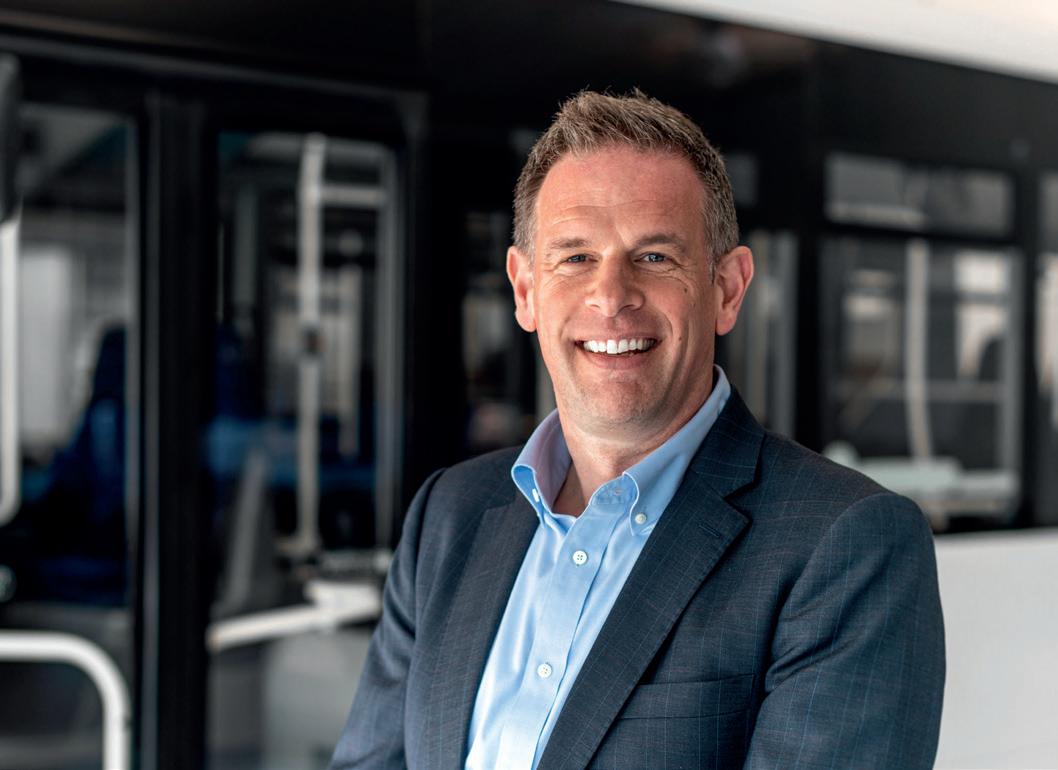
Paul
'It is
Despite these benefits, UK manufacturers face an uneven playing field. Current procurement practices and subsidy controls often disadvantage domestic firms. The Subsidy Control Act 2022, for instance, prohibits preferential treatment for UK-made goods, undermining the ability to recycle public investment into local jobs and innovation. Labour rates in the UK are multiples higher than those countries we compete with for bus orders, our energy costs are four times as much, we are commercially disadvantaged when procuring battery systems, and on the home front rising business taxes further erode competitiveness, leading to job losses and reduced investment. Reforming public procurement is critical. Mandating robust social value criteria, such as job retention and creation, skills development, as well as UK supply chain spend, can ensure that contracts deliver measurable benefits for British industry. Standardised targets and higher weighting for social value would level the playing field, allowing UK manufacturers to compete on total economic value. By
recognising national supply chains and strategic industrial hubs, the UK would be able to maximise the impact of bus procurement decisions across regions.
Countries like the US, Australia and Canada have shown that pro-domestic content rules and long-term planning can drive industrial growth. For example, we have recently invested millions of pounds in a Las Vegas facility in response to local requirements from the US government for public procurement and have made similar investments in Canada in the past.
Australia’s New South Wales
“If we want to safeguard jobs, drive innovation, and ensure that public funds are reinvested into the UK’s economy, and not sent overseas, we must act now to support domestic manufacturing”
(NSW) demonstrates how domestic content rules and longterm planning can drive industrial growth. In August 2025, NSW ordered 151 battery electric buses for Sydney, exceeding its 50% local manufacturing target, supporting Australian jobs and reinvesting public funds into the domestic economy. NSW’s strategy contrasts with past reliance on overseas suppliers, showing how procurement can fuel innovation, job creation, and sustainability. Looking closer to come in the UK transport industry, HS2 set a new benchmark for UK infrastructure procurement, combining transparency, technical rigour, and market openness. Its rolling stock contract, worth £1.97bn, was awarded to AlstomHitachi Rail, supporting UK jobs and manufacturing. HS2’s published pipeline gave UK firms visibility of over 300 work packages. Procurement also embedded equality, diversity, and sustainability, doubling SME spending to £942m in one year and boosting local trades - setting new standards for social value and collaboration across the construction sector.
The evidence is clear: supporting domestic UK manufacturing through strategic procurement and industrial policy is not just an economic imperative, it is a matter of national resilience. To secure the future of UK manufacturing, the UK Government must act now to reform procurement rules so that social value - UK jobs, skills, and supply chain - takes centre stage in contract decisions. By learning from international models and reforming outdated regulations, the UK can unlock the full potential of its manufacturing sector, create high-value jobs, and secure a prosperous future for generations to come.
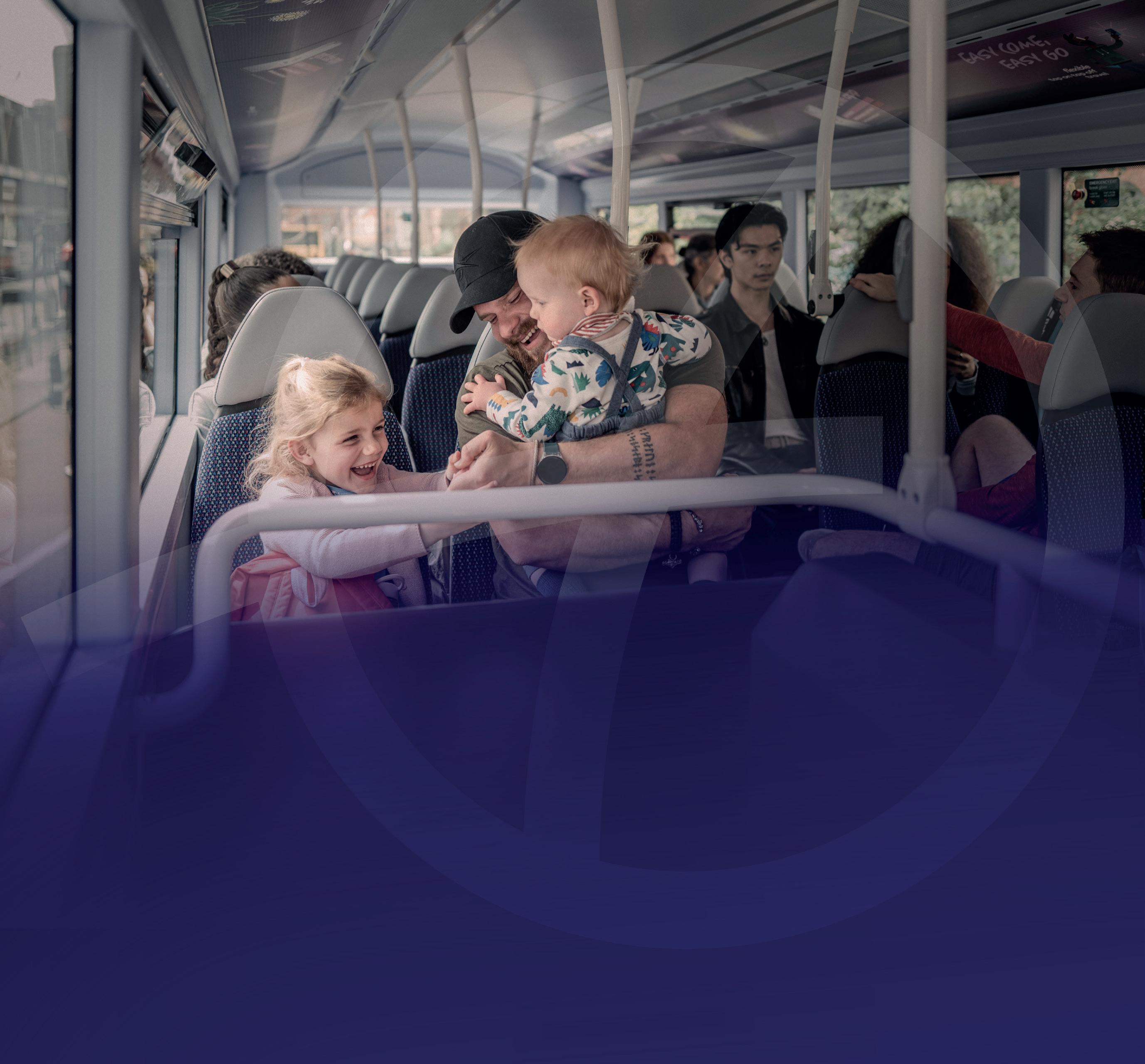
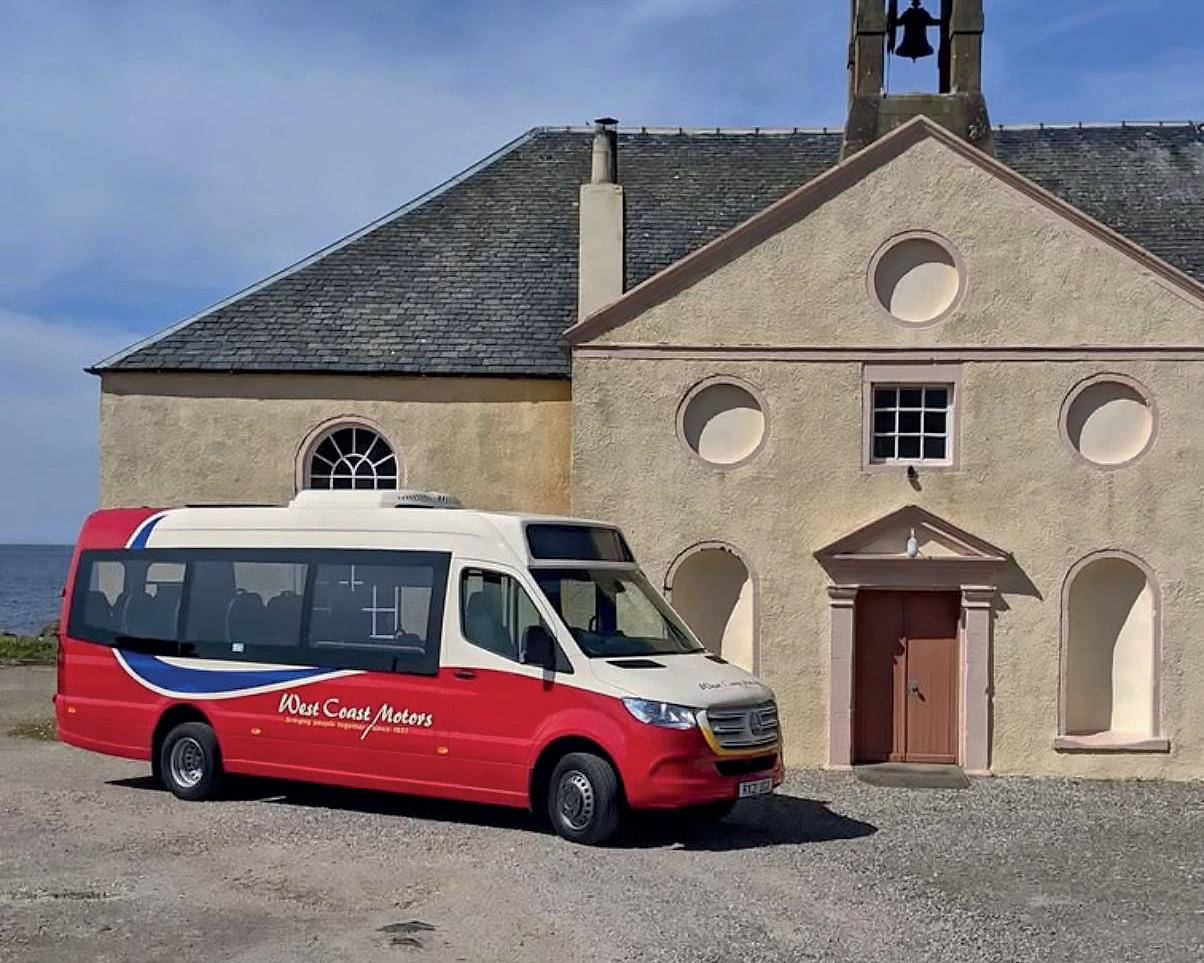
It Just Works for Us
“Our Cityline fleet has proven itself time and again,” says Colin Craig of West Coast Motors. “The layout, accessibility, and ride quality make it ideal for both our urban services and our rural community routes.”
The Cityline’s combination of comfort and reliability makes it a cornerstone of their local service, easily navigating tight village roads where larger vehicles can’t.
Unmatched Support from EVM
“EVM have been fantastic to deal with,” Colin adds. “From the initial build to delivery and aftercare, their communication and technical support have been first class.”
EVM UK’s responsive aftersales support and reliable network are invaluable.
Building for the Future
West Coast Motors is now looking ahead to the e-Cityline. “EVM’s willingness to innovate—while still maintaining the practicality and quality we value—makes them a natural partner for the next stage of our minibus fleet development,” Colin concludes


In every corner of Scotland, buses are quietly but powerfully driving economic, social, and environmental progress. They are the arteries of our cities, towns, and rural communities - connecting people to jobs, education, healthcare, and local shops. When we invest in buses, we unlock growth that is fast, inclusive, and sustainable. No other mode of transport delivers such a high return, so quickly.
Research from KPMG confirms what the industry has long understood: bus passengers in Scotland contribute nearly £3bn to local economies each year. Of that, an estimated £570m is additional spend on Scottish high streets - money that simply wouldn’t be there without accessible, reliable bus services.
Every £1 of targeted public investment in buses generates £4.55 in economic benefits. That is not just good value; it is smart economics.
We are proud to be recognised as Scotland’s Public Transport Operator of the Year, but we know there is more to do. And we cannot do it alone.
Transforming travel across Scotland requires deep collaboration - between operators, local authorities, regional transport bodies, and government. We are calling for stronger, longer-term partnerships, built on mutual accountability and investment. Voluntary, legally binding agreements offer a pathway to deliver measurable benefits for customers, communities and taxpayers. By providing confidence and clarity for all
resources just to keep services on track - but that money could be better spent expanding routes or reducing fares, if only we had more consistent and effective bus priority measures in place.
The Scottish Government’s Bus Infrastructure Fund is a vital step forward, and we welcome the £20m allocated for 2025-26. But more is needed. Will there be a long-term, multi-year spending commitment to allow for sustained infrastructure improvements and better network planning? We stand ready to work closely with local and national partners to make this happen - not just through funding, but through joint action to better coordinate and manage the road network for the benefit of bus users.
Buses are already the first choice for many Scots travelling to work, school, medical appointments or for leisure. But to maintain and grow that role, reliability is key. Our customers consistently tell us they want services that run on time - and rightly so.
partners, they enable bolder action - now and in the future.
To truly deliver seamless, reliable, and inclusive public transport across Scotland, we must tackle head-on the challenges that prevent buses from reaching their full potential. Congestion and disruption from roadworks are the biggest threats to service reliability and customer satisfaction. Due to slower bus journey speeds caused by congestion, we’ve invested over £3m in additional operational
“We know that when buses are reliable, accessible, and clean, more people choose them”
Alongside service reliability, we are making strong progress on the decarbonisation of our fleet. We’ve invested over £60m since 2021 with support from SULEB and ScotZEB funding to deliver over 250 zero emission buses, over 40% of our Scottish fleet. We’re also pioneering innovative approaches like ‘repowering’ diesel vehicles to electric and opening up our EV charging infrastructure to the wider community through our First Charge initiative. From Glasgow’s Caledonia depot to locations across the UK, we’re supporting not just cleaner air, but a just transition to net zero.
We know that when buses are reliable, accessible, and clean, more people choose themreducing congestion, cutting carbon, and boosting local economies. But achieving this at scale requires a step change in how we work together.
Let’s make the most of the tools at our disposal - from smart infrastructure investment to smarter partnerships - and ensure that buses remain at the heart of Scotland’s economic and environmental future.
Let’s keep Scotland moving, together.
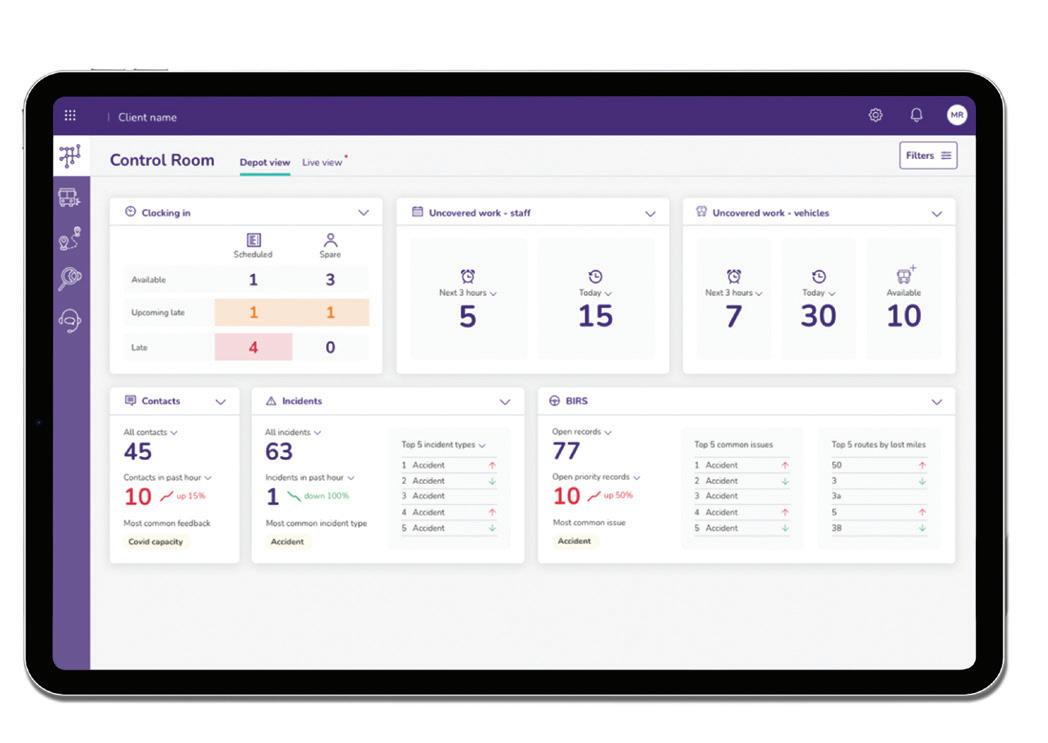























Bus operators across the UK face increasing demands to run networks that are not only reliable but also more e cient and responsive. Managing driver resources, tackling congestion and maintaining consistent services all hinge on one place: the control room.
Historically, however, control rooms have operated with fragmented systems, requiring sta to juggle multiple screens and manually retype data to piece together the whole picture. is slows decision-making and increases the very real risk of service disruption.
Furthermore, the broader transport landscape is undergoing rapid changes. Rising passenger expectations, tighter regulatory requirements, and the push towards greener, more sustainable operations are all adding to the pressure. Operators need not only to react in the moment, but also to anticipate issues before they escalate into something greater, a factor that traditional systems are rarely equipped to deliver.
Nick Brookes, Chief Customer O cer at Velociti Solutions, explains: “ e control room is the heartbeat of any bus operation. However, without a uni ed system, controllers o en work harder than necessary to stay on top of the basics. at’s where Control360 changes the game.”
A single view of operations Control360 uni es data from across the organisation, from scheduling and engineering to customer services and third-party systems, into one intelligent hub. For the rst time, controllers can see what’s happening across the network in real time in one place.
“Most operators already have lots of technology in place,”
says Nick. “ e challenge has been joining it up. Control360 delivers that single, joined-up view, enabling teams to plan more e ectively, respond more quickly, and provide passengers with the reliability they expect.”
From reactive to proactive e platform goes far beyond monitoring. With real-time alerts, predictive insights, and streamlined work ows, Control360 enables controllers to act before minor issues escalate into more signi cant service failures.
Aiden Proctor, Velociti’s Head of Product - Bus, gives an example: “If a driver is delayed in signing on, that can quickly impact multiple services. Control360 doesn’t just ag the issue; it helps the team resolve it quickly, compliantly and cost-e ectively.”
By eliminating the need for duplicate data entry and systemhopping, the so ware frees up controllers to focus on what matters most: keeping buses moving and passengers informed.
Better decisions, every day
With its intuitive graphical interface, Control360 highlights the most urgent issues while also providing the context behind them, whether that’s a driver’s work history, incident timelines, or network-wide impacts.


“The control room is the heartbeat of any bus operation. However, without a unified system, controllers often work harder than necessary to stay on top of the basics”
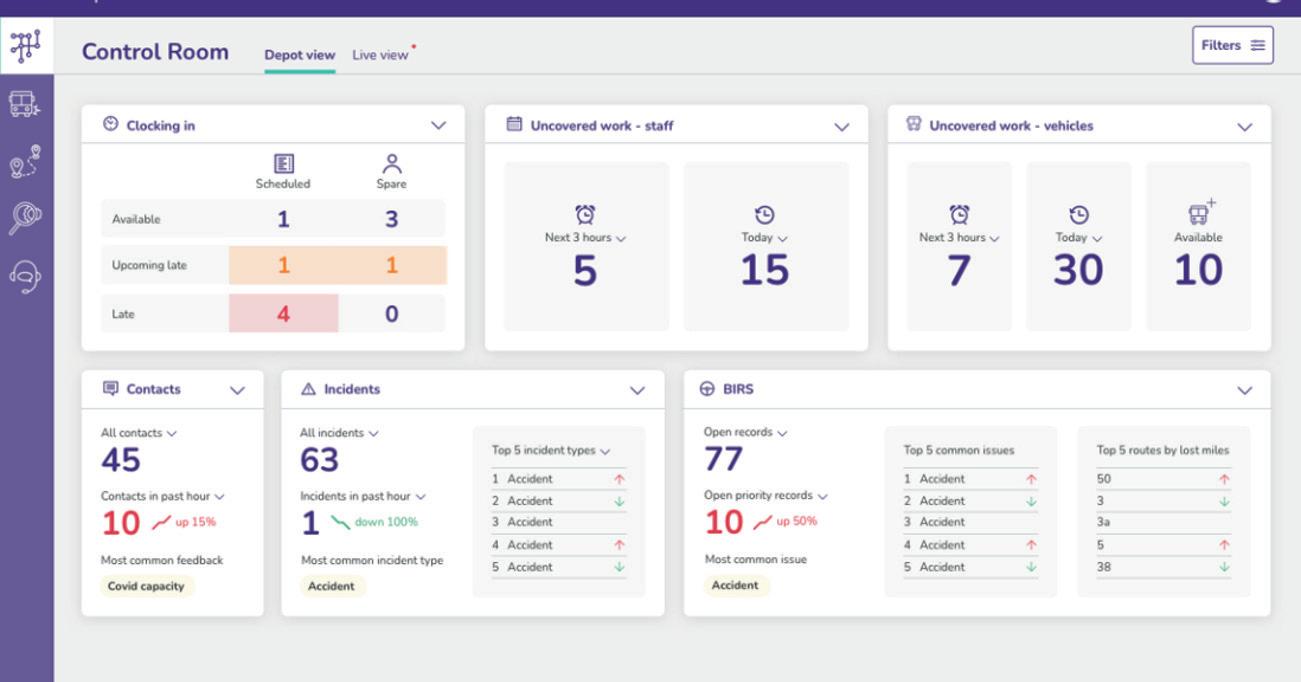
“Controllers make high-stakes decisions under pressure all the time,” notes Aiden. “Control360 ensures those decisions are based on facts, not assumptions.”
Over time, the platform also builds a rich dataset that operators can use to inform longterm planning. Patterns emerge, such as how school schedules a ect punctuality, or which types of incidents most o en cause lost mileage.
Nick explains: “ ese insights help operators reshape networks in ways that deliver lasting improvements.”
Built for the future
More than just a piece of so ware, Control360 represents a shi in how bus operations are managed. It bridges the gap between day-today service control and strategic planning, paving the way for more intelligent, data-driven networks.
Crucially, the platform is designed with adaptability in mind. As new technologies emerge, from electric eets to AI-driven scheduling, Control360 can evolve in tandem with them. is ensures that operators are not locked into today’s solutions but are equipped to embrace tomorrow’s innovations without disruption.
“Control360 is already transforming how operators run their networks,” says Nick. “And this is just the start, the platform will only get smarter, faster and more connected as time goes on.”
From proactive duty allocation and predictive network management to seamless integration across systems, Control360 is setting a new standard for what a control room can achieve.
Or, as Aiden puts it: “It’s not only about solving today’s challenges, it’s about building bus operations that are ready for the challenges of tomorrow.”



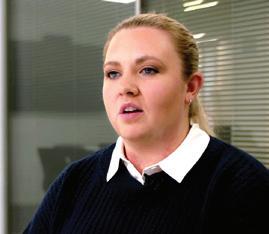


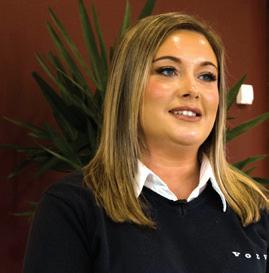

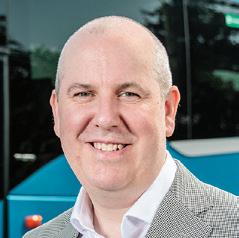









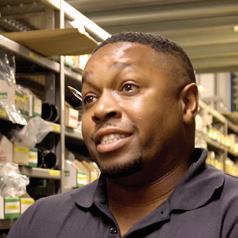

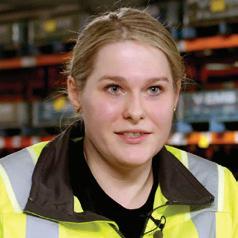




47th Annual CPT Conference
October 27-28, 2025
Kimpton
Edinburgh
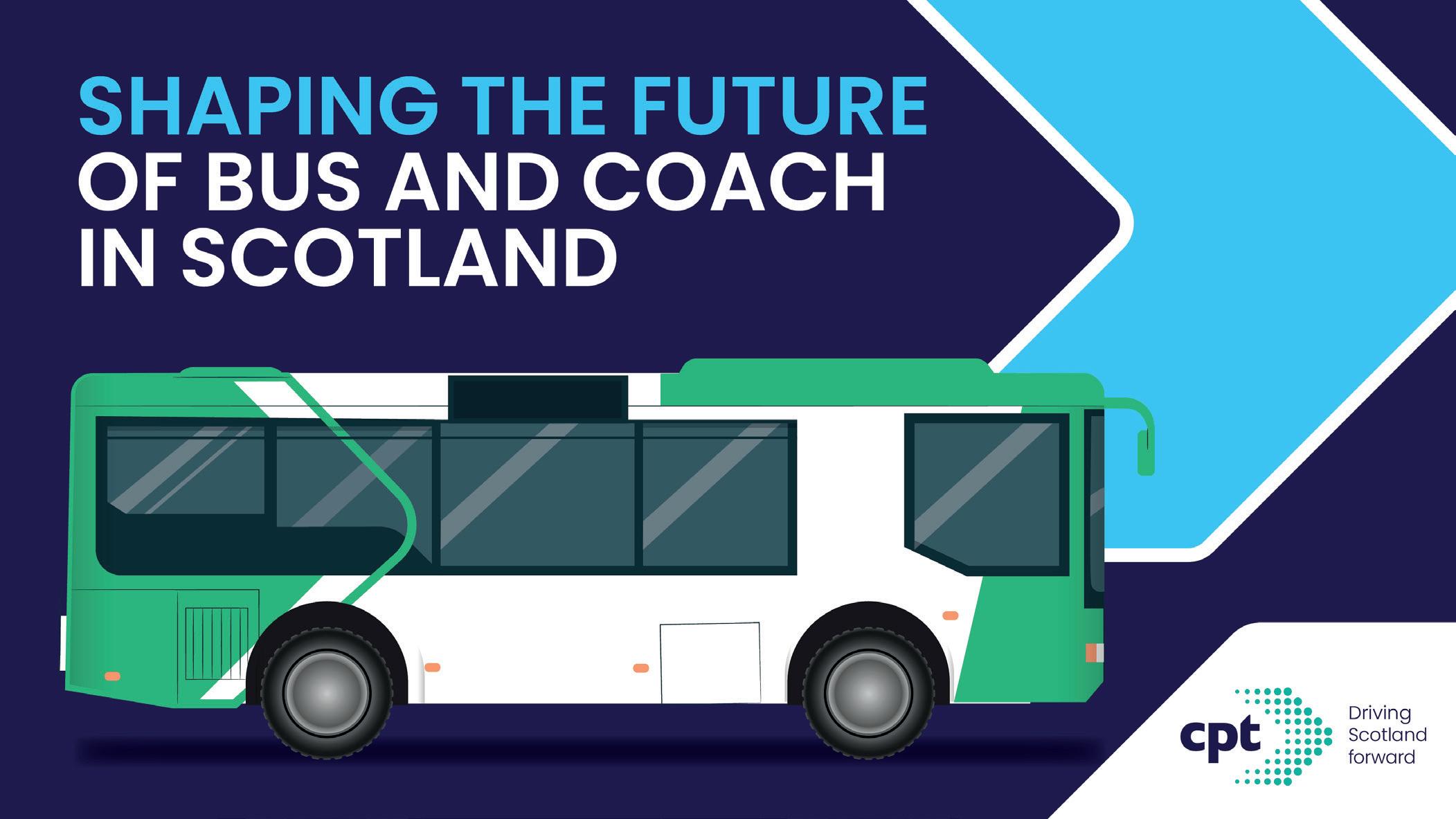

















Thank you for joining us at the 47th Annual CPT Scotland Conference.
is year sees a change of venue as we move to Edinburgh and the Kimpton Hotel. I am con dent the Kimpton will be a fantastic location, with excellent transport links, and exhibitor, networking and conference space. e Kimpton is situated on Charlotte Square, just around the corner from the First Minister’s residence, Bute House. Maybe if our speakers are loud enough, we might be able to in uence Mr Swinney too!
is year our charity partner is Age Scotland. eir aim is to improve the lives of people
over the age of 50 in Scotland by providing help and support, promoting age and dementiafriendly communities, delivering wellbeing programmes, and campaigning on behalf of older people. It is a fantastic cause, and we will be looking to support them with a ra e through Conference dinner.
Despite the changes to venue and charity partner, many aspects of conference remain the same. We continue our focus on expanding our audience to include more of our public sector partners and other transport and tourism stakeholders. Our aim is to foster debate around the issues that matter to us all. Given that so many aspects of our future are dependent on the actions taken
by local, regional and national government it is important to include their voices.
Our conference title this year is ‘Shaping the Future’. How do we proactively tackle the challenges and opportunities that lie ahead to deliver better bus and coach services? is is also the title of our manifesto for next year’s Scottish Parliament elections, which we’ll launch at conference. is question has many facets. How do we harness new technologies and evolve to ensure we are engaging with young people both as customers and employees? How do we nd new solutions to existing problems, such as congestion or the provision of rural transport? How do we better work with
local and regional government to create a future that bene ts us all, be that around bus regulation or facilitating coach travel and tourism?
ese are among the issues we aim to address through our conference sessions, and I’m delighted that we have such an outstanding set of speakers and panellists to help us tackle them. I look forward to spending the next two days in your company and hopefully by close of conference the path to a better future for bus and coach will be a little bit clearer.

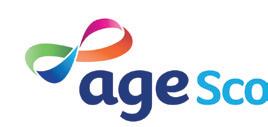

Age Scotland improves life for those over 50, o ering a free helpline, supporting community groups, promoting age- and dementia-friendly initiatives, delivering wellbeing programs, and advocating for older people across Scotland.
■ agescotland.org.uk

Altro has spent over 60 years creating high-quality transport safety ooring, o ering innovative thermal and acoustic solutions that enhance zero-emission vehicles, improve e ciency, and create inclusive, accessible public transport spaces.
■ altro.com/uk

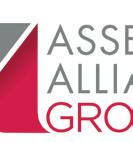

Asset Alliance Group, an awardwinning nance specialist for over 20 years, streamlines bus and coach nancing, procurement, and acquisition, o ering tailored lease, rental, and purchase solutions to suit your business.
■ assetalliancegroup.co.uk


Backhouse Jones, an awardwinning law rm with an unrivalled reputation, advises most of the major operators in the UK in addition to many smaller family-owned enterprises and provide a full suite of legal services, training and compliance reviews to the transport sector.
■ backhousejones.co.uk

DKV Mobility, Europe’s leading B2B platform, provides fuel, toll, EV charging, and digital eet solutions, helping bus and coach operators streamline operations and reduce costs.
■ dkv-mobility.com

EVM, a leading UK and Ireland minibus and coach specialist, o ers luxury, school, accessible, and electric vehicles, backed by expert a ersales support and tailored solutions to meet every operator’s needs.
■ evm.uk
Ferdia’s cloud solutions streamline coach operations, optimise resources, reduce empty journeys, simplify scheduling, and enhance customer experience.
■ ferdia.co

Ferrymill Motors, a 50-year family business, specialises in bus and coach repairs, conversions, refurbishments, and claims management.
■ ferrymillmotorsltd.co.uk


A family-run business with 20+ years’ experience, providing vehicle livery, signage, and graphics, we deliver high-quality and competitive solutions.
■ gordanagraphics.co.uk

Journeo delivers end-to-end transport technology, integrating so ware, hardware, and support for smarter, safer, and seamless passenger journeys.
■ journeo.com



Passenger’s digital platform empowers public transport operators with mobile ticketing, live travel data, and app integration via Passenger Cloud, enhancing customer experienc.
■ passenger.tech

Pelican Bus & Coach is the sole UK and Ireland importer and distributor for Yutong buses and coaches. It is wholly owned by Pelican Engineering, which was rst established in 1919
■ pelicanyutong.co.uk


Portland, fuel experts since 2009, o er xed-price deliveries, hedging, AdBlue® supply, and procurement solutions for bus and coach operators of all sizes.
■ portland-fuel.com

PSV Glass & Glazing, the UK’s leading specialist glass distributor and installer for the bus and coach industry, are proud to support the CPT Scotland Conference.
■ psvglassandglazing.co.uk

SAM, a not-for-pro t membership organisation, helps bus operators and public bodies access a ordable, best-in-class ITSO smart ticketing services through pooled expertise and managed solutions.
■ talktosam.co.uk



Ticketer is an innovator in transit, helping operators o er seamless passenger experiences and deliver operational excellence. As a trusted technology partner, Ticketer provides a suite of solutions, o ering a ticketing platform, data and analytics hub, and advanced eet management tools.
■ ticketer.com



We deliver end-to-end digital solutions and consultancy, optimising timetables, sta , and operations, enhancing e ciency, revenue, and patronage, while supporting transport authorities with performance monitoring, and grant compliance.
■ velociti-solutions.com

Volvo Bus UK and Ireland is a leading provider of innovative and sustainable public transport solutions. With a strong commitment to safety and environmental responsibility, we o er a range of reliable buses and services designed to enhance urban mobility.
■ volvobuses.com/gb


